
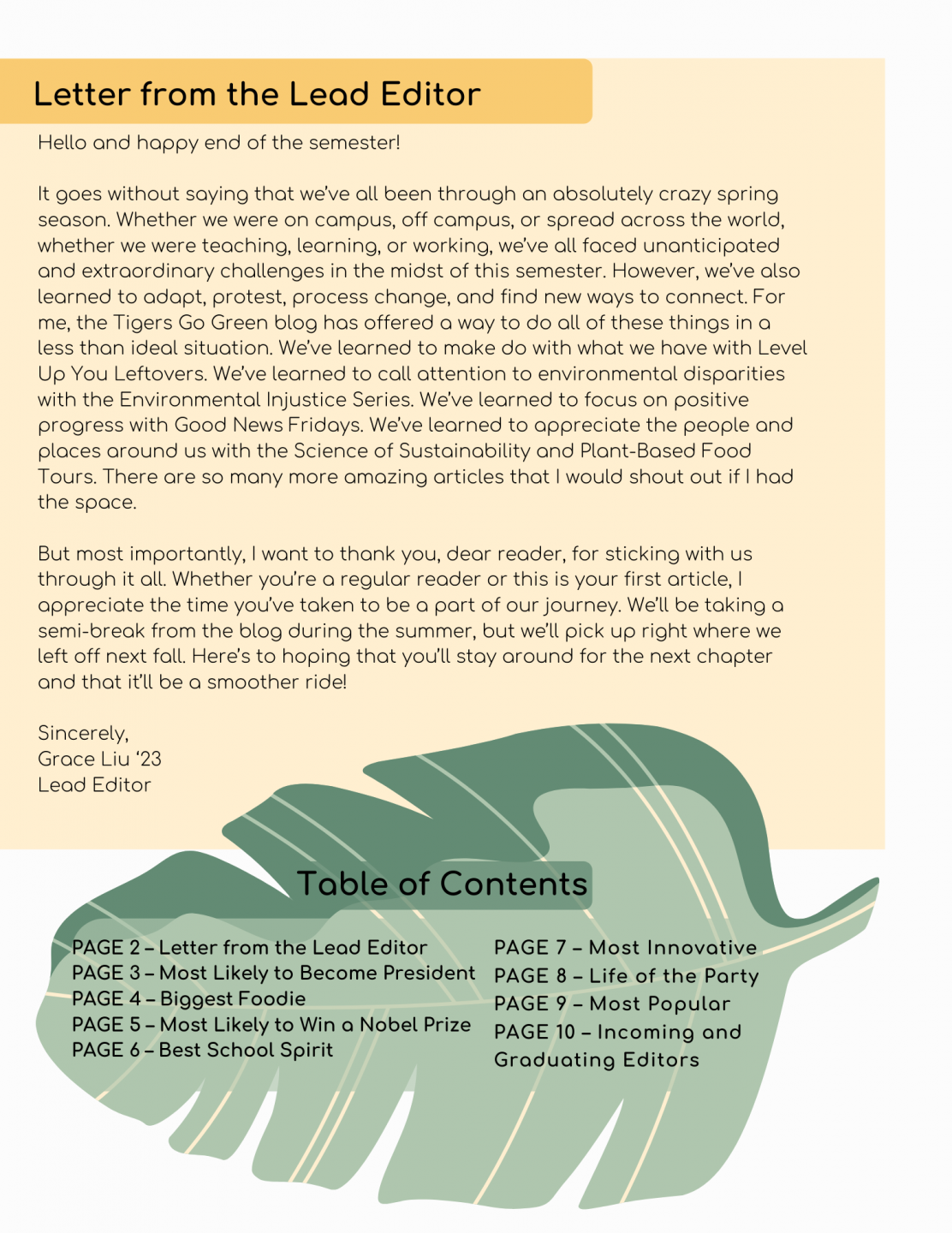
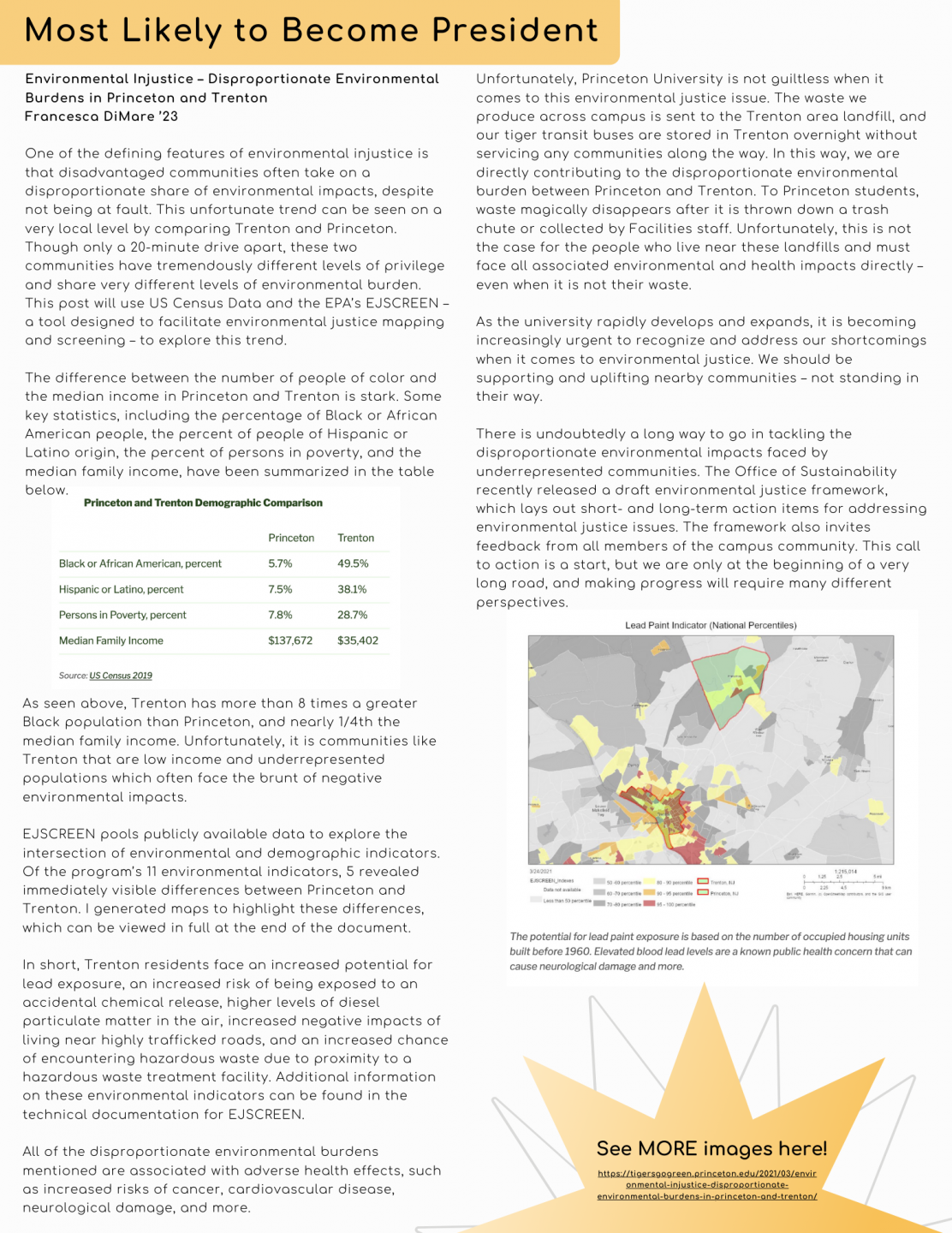
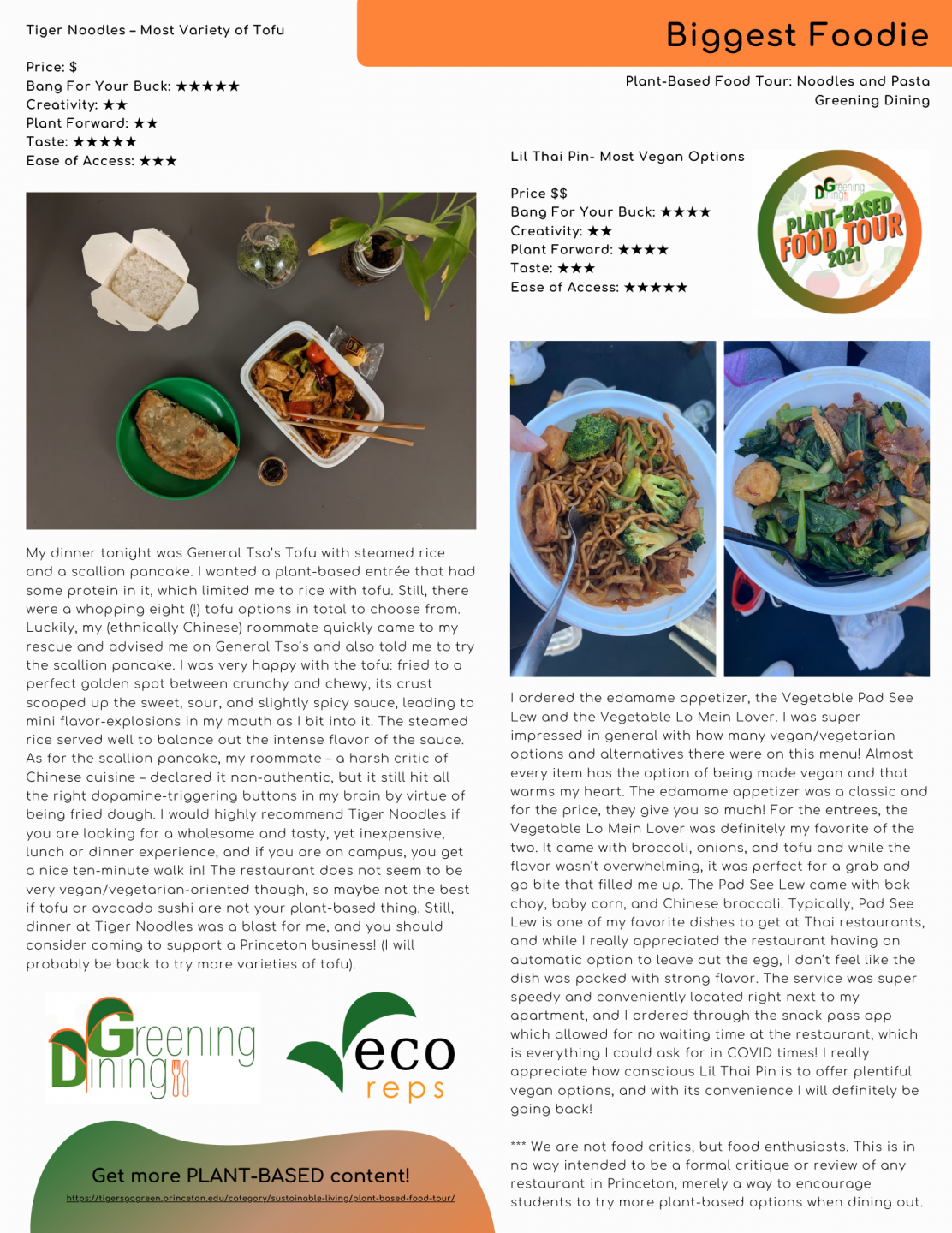
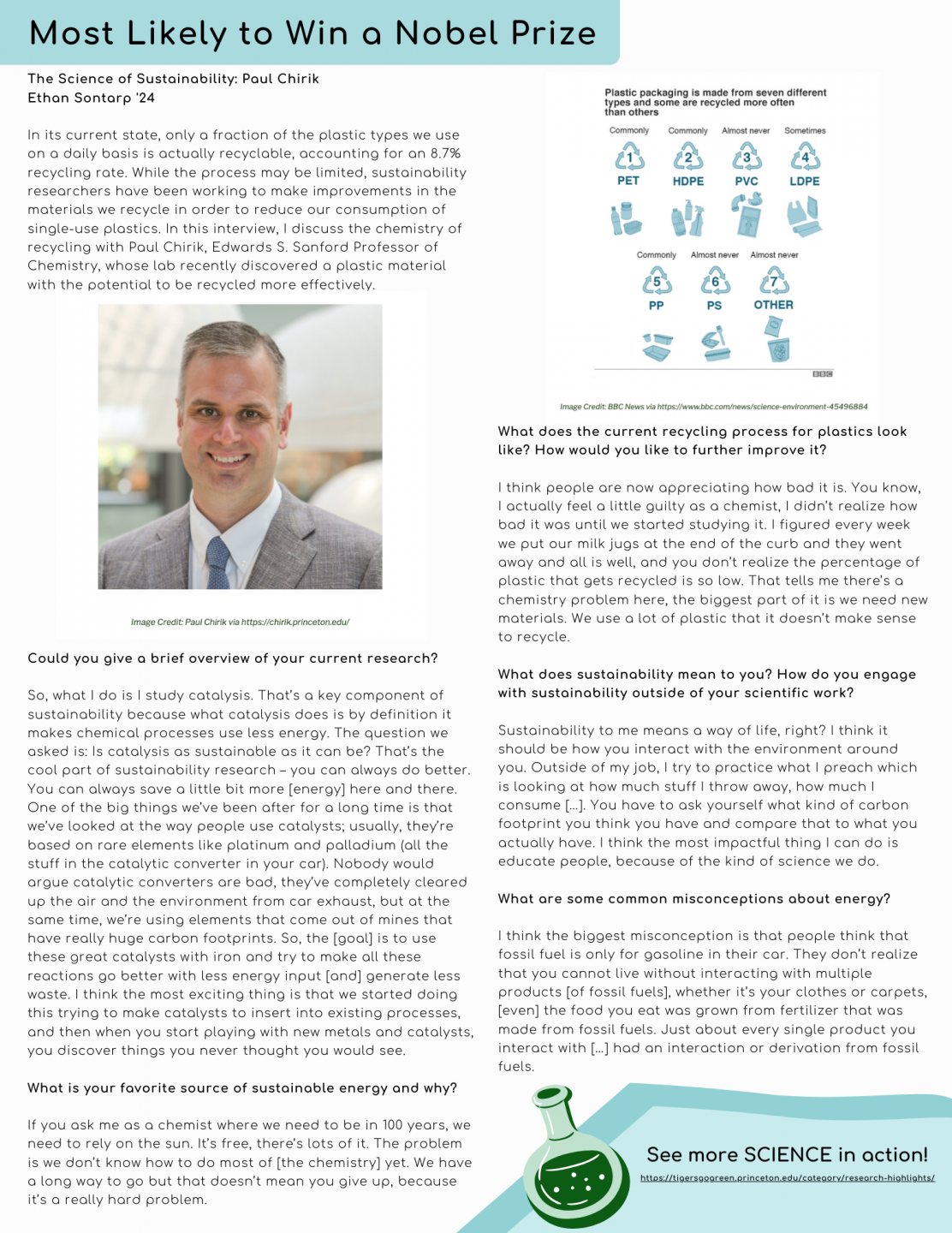
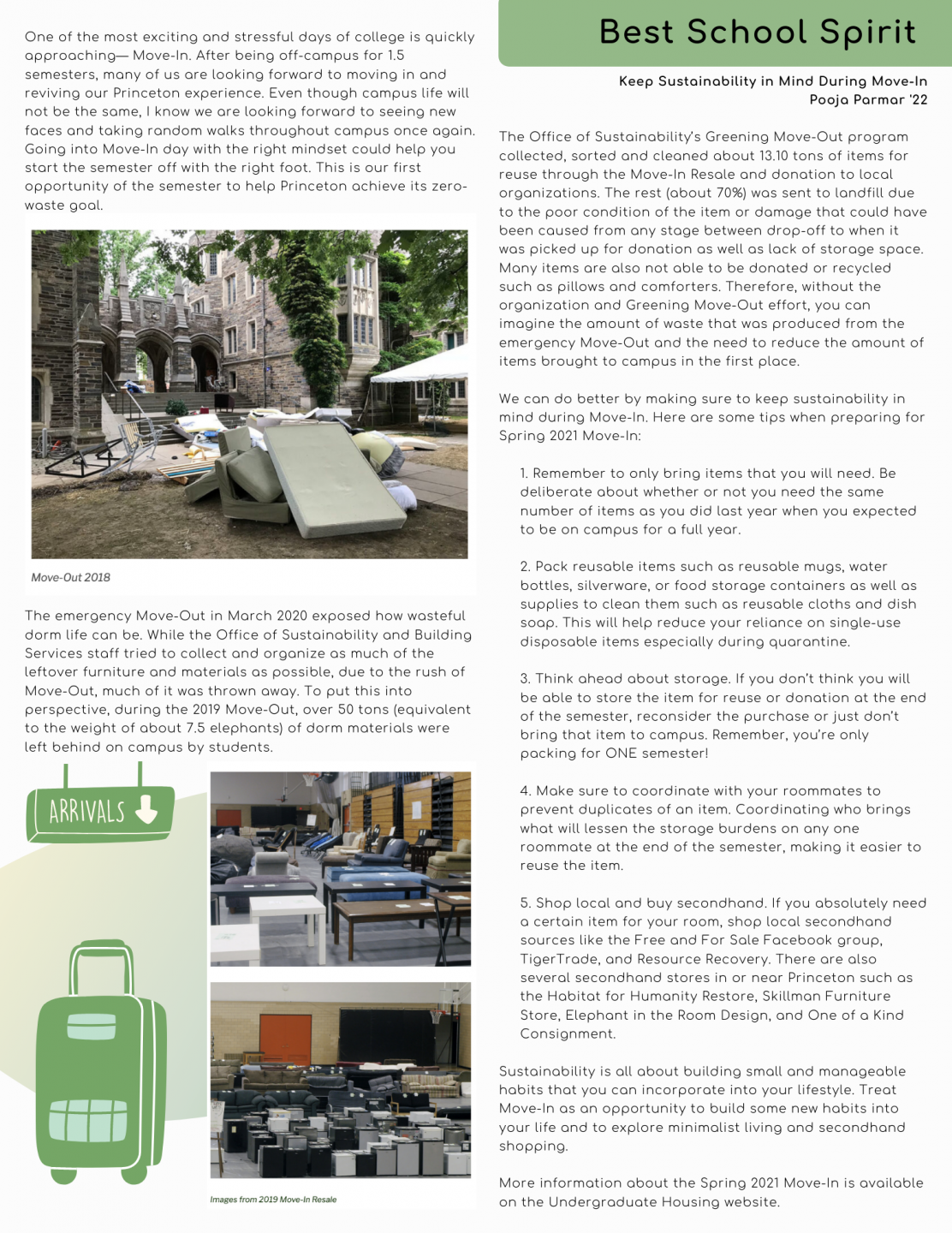
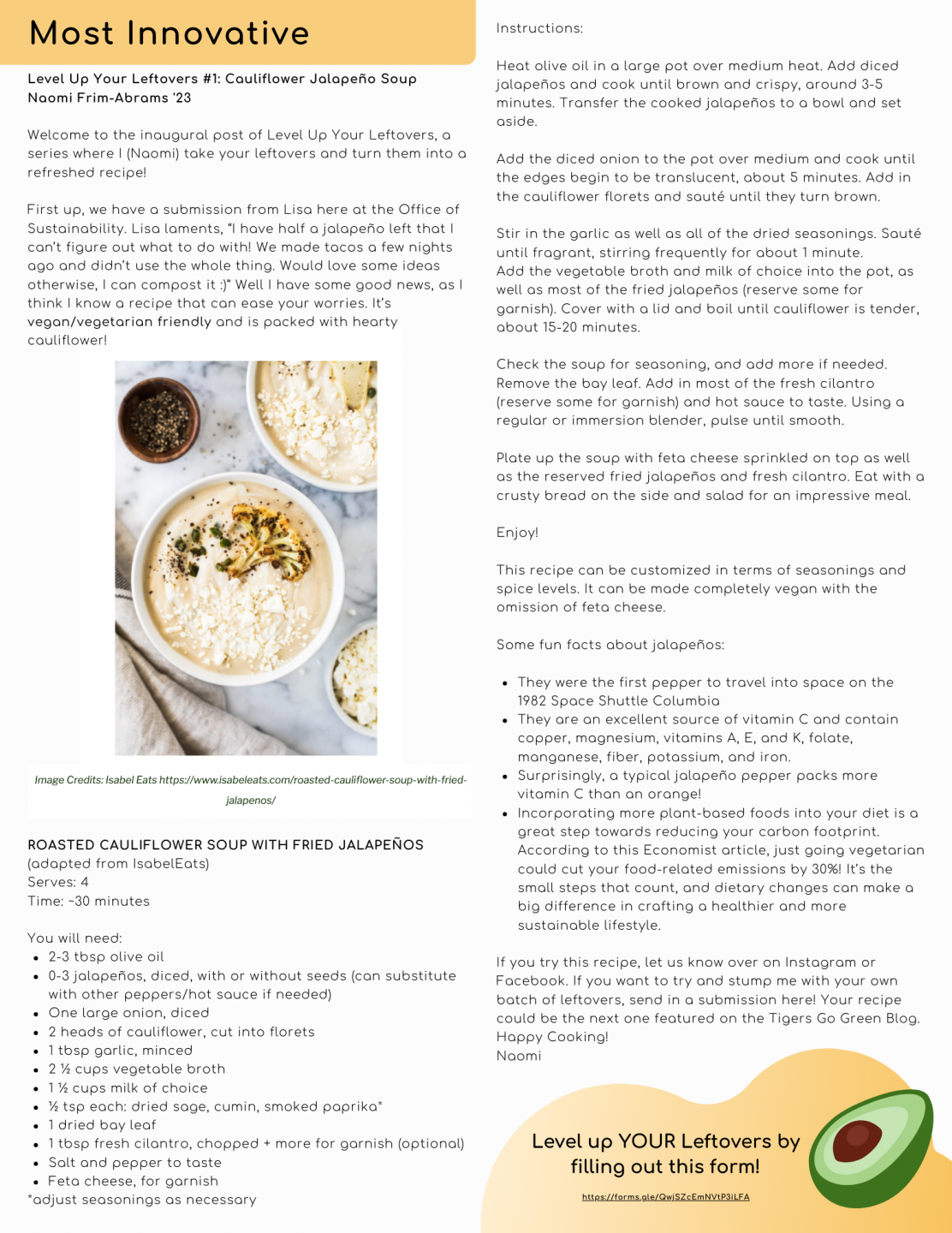

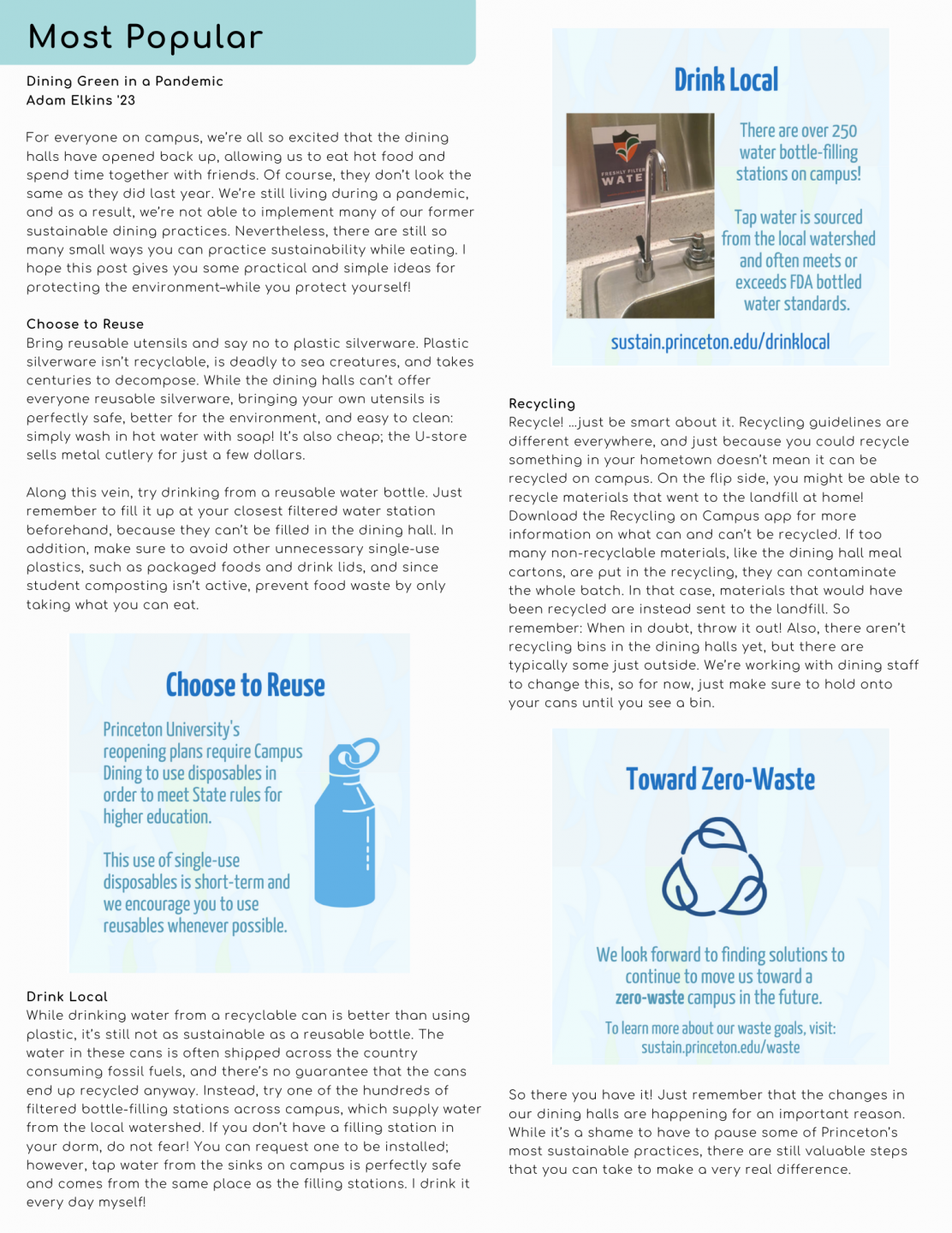

Author: Camellia Moors ‘22
When nuclear power is used on a commercial level to produce electricity, one unavoidable byproduct is high-level nuclear waste (HLW) in the form of spent fuel rods. Currently, the only strategy the United States has to manage this waste, which takes thousands of years to decay, is to build a site underground, known as a permanent repository, where the waste can be stored until no longer dangerously radioactive. The only problem with that plan? The U.S. does not have a permanent repository built, and the only substantive plans for a storage site in Nevada have been plagued by political obstacles and local opposition.
For my junior independent work as part of my task force for the School of Public and International Affairs, I analyzed the current state of repository policy, why climate change might make the need to figure out a permanent solution even more urgent, and what policy changes could be implemented to streamline federal decision making on nuclear waste. My paper is titled “Commercial High-Level Nuclear Waste in the United States: Overcoming Political Barriers to Short- and Long-Term Storage Solutions.” I chose to examine nuclear waste because with climate change growing worse, there are a lot of questions about whether nuclear power, as an emissions-free electricity source, should be part of a renewable energy transition; these questions, however, tend to ignore existing issues of nuclear waste, which will only grow if nuclear power increases. I also was really interested in the idea of bringing climate change directly into this debate.

On-Site Waste Storage, Political Obstacles, and Climate Change
Due to the lack of a permanent repository, America’s 80,000 metric tons of domestic HLW from commercial nuclear power (CNP) is temporarily stored on-site at nuclear power plants, as the map above shows. The operation of existing nuclear power plants increases that HLW by 2,000 metric tons/year. In my analysis of the causes and consequences of this on-site storage dependence, I found:
In other words, my analysis found that the United States’ nuclear waste problem will grow more expensive, unsafe, and dire the longer a solution is delayed.
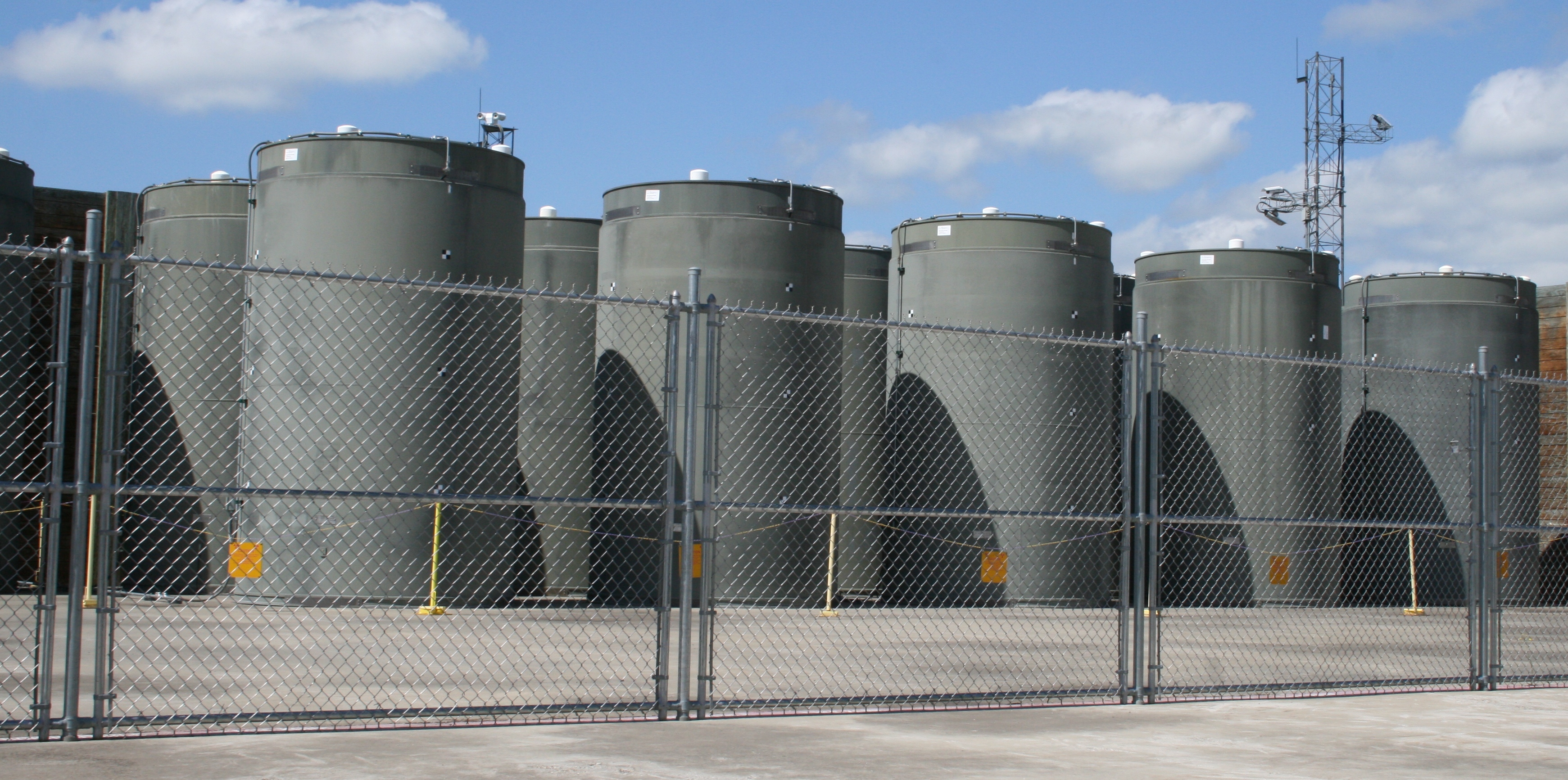
Fixing the Problem
In light of my findings, I made a list of policy-based recommendations which could reduce the current strain on temporary on-site storage in the short term and/or bring the United States closer to constructing and operating a permanent repository in the long term:
America’s nuclear waste storage problem is a complicated one, but that is all the more reason why it cannot continue to be ignored. Questions of nuclear power’s role in America’s energy transition to confront climate change cannot be fully and accurately answered until short- and long-term HLW storage solutions are implemented.
Author: Wesley Wiggins ‘21
Sea-level rise is a local phenomenon just as much as it is a global one. While melting ice sheets, mountain glaciers, and the expansion of the oceans all have far-reaching impacts, every coastline will experience sea-level rise differently. I focused my senior independent work for the Department of Geosciences on the effects of sea-level rise in one location in particular: the Chesapeake Bay.
In my senior thesis, titled Sea-Level Rise on the Eastern Shore of Maryland: Vulnerability, Adaptation, Environmental Justice, I analyzed sea level rise data in Cambridge, Maryland, and conducted a survey to understand residents’ experience with rising sea-levels and their adaptation preferences. I chose to study the Eastern Shore because it is an area close to my own home in Washington, DC. Having visited the Bay many times, I’ve seen the beauty of the environments and the wonderful residents. The Eastern Shore is home to a large African American population, a group that is particularly vulnerable to the effects of sea-level rise because of a lack of access to resources, lack of representation in decision-making circles, and historical discrimination.
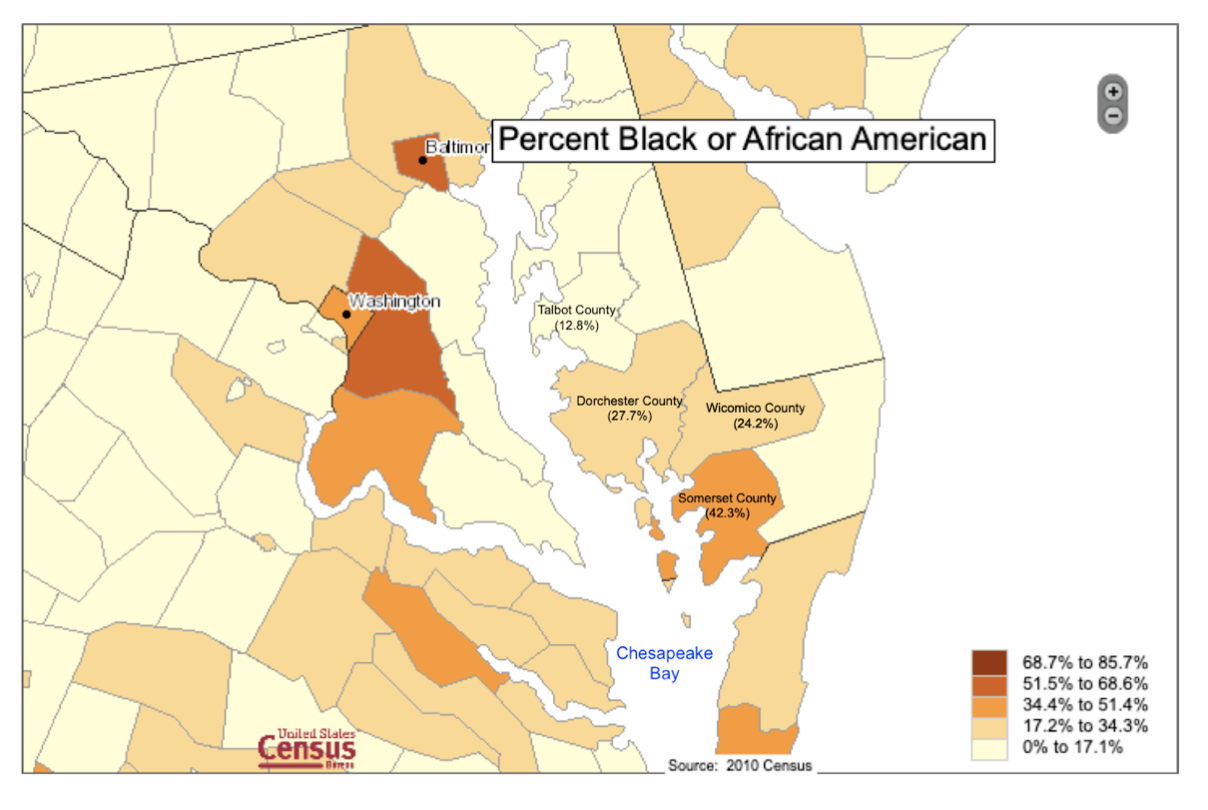
Sea Level Rise Analysis
From an analysis of local sea-level projections until 2100, I found that the sea level may increase by an average value of 88 cm, relative to mean sea level in 2000, if global temperatures rise 2˚C by the end of the century. If global temperatures rise by 5˚C, then the average sea levels may rise by an average of over 140 cm. Additionally, there is around a 36% probability that sea levels will rise by 1 meter or more in a 2˚C scenario and about 75% probability of this in a 5˚C scenario.
For some historical context, Hurricane Isabel made landfall in Maryland on September 19th, 2003 and caused water levels to rise to 1.26 m. This event flooded almost half of Dorchester County, cut off power to 1.4 million Maryland residents, injured 200 people, and even killed 1 person. The current frequency of a 1.26 m water level rise occurring is 1 in 286 years. By 2100, we will see these events amplified by 2000 in a 2˚C warming scenario with 7 events per year, and amplified by over 8500 in a 5˚C warming scenario, with 30 events per year.
Survey of Residents
In my survey, I asked if residents would support a seawall, a barrier parallel to the shoreline which defends the coast against sea-level hazards, or would rather a relocation program such as managed retreat. The majority of residents supported a seawall, but had mixed feelings towards relocation, with a most opposed to leaving their homes. Community preservation was a big explanation for supporting seawalls, which many saw as a plausible solution when used with other techniques. Some saw managed retreat as the best option while others saw it as a last resort. Others believed that by relocating their homes, their land would be given to more wealthy individuals, which made them unwilling to move. Residents gave many reasons for taking different positions on adaptation efforts, yet many of them are rarely heard by the groups that make decisions. When the voices of the community are not heard, the people that need the most help could actually end up being more hurt than helped by adaptation efforts.
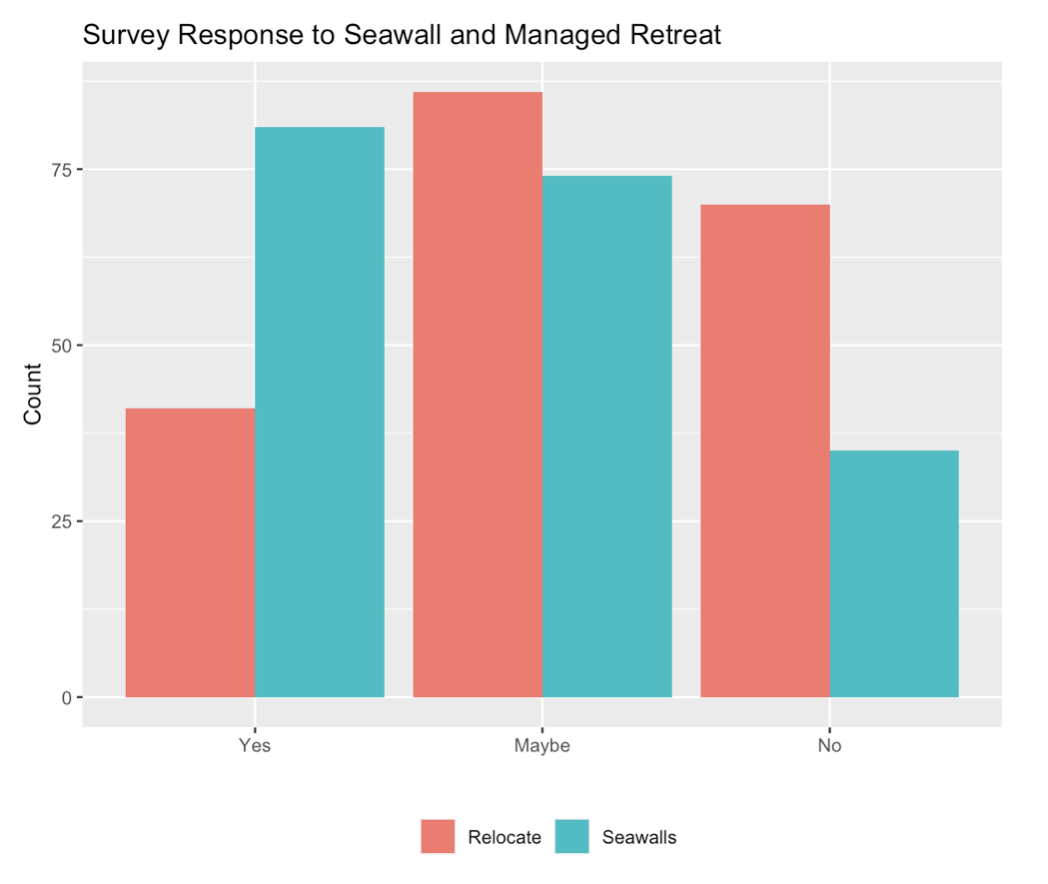
It is important to remember: How we take action is equally important to or even more important than taking action. The people who make adaptation decisions should change how they operate to accommodate these communities. This could mean increasing the transparency in decision-making process, increasing the consideration of social injustices in long-term adaptation planning, and engaging in participatory planning. Improving these practices can help to decrease the environmental injustices present in the Chesapeake Bay, but we shouldn’t stop there. These practices should be implemented beyond the Chesapeake Bay in order to pursue environmental justice on a global scale.
Author: Jayla Cornelius ’23
As an ending to this environmental justice series for the semester, it is important that we shine light on the positive things being done and how you all can continue with this forward momentum. Although the history of environmental injustices is grim and its toll on low-income/minority communities has proved detrimental, we can continue showing up for these communities and making a difference. All around the country and world, there will continue to be people in need of our help so that they can be provided with the contaminant-free water, non-toxic air, and clean natural environment that they deserve. One’s socioeconomic status or race should not factor into whether or not they are afforded a clean environment. It should neither impact the decisions of whether large corporations find it admissible to put certain communities in danger. As a collective, we have the privilege of being in a position to mitigate the effects of past environmental injustices and prevent future instances from occurring.
One particular way that students and community members can use their voices to speak out against environmental injustices is to contact their state representatives. States like Arizona, Virginia, Pennsylvania, and plenty more have environmental justice committees that focus on not only the preservation of natural resources but also its outstanding impact on particular communities in the state. By reaching out to representatives and asking questions, we can all become more knowledgeable about the efforts being made and the laws being enacted to help disproportionately disadvantaged communities. Through actions such as cold-calling, sending emails, holding protests, etc. we can make a substantial difference if enough pressure is applied to get some of these proposals approved by the committees. Through these actions and partnering with grassroots organizations with common goals, the Princeton community can do its part and embody the values that make this campus so special. Through service and advocacy, we have already been able to push forward many really important sustainability initiatives, and I am confident we will continue to make positive contributions to surrounding and distanced communities.

To give tangible examples, in the state of New Jersey, there are numerous grassroots organizations and departments such as the New Jersey Environmental Justice Alliance, Clean Water Action, and the Clean Air Council. They all focus on unique aspects of the environmental justice movement to help impact the water quality, air quality, and the quality of life in areas around the state. Many students can get in touch with these organizations to see what ways that can help, whether that be attending cleanup events, cold-calling for increased funding for projects, or simply spreading awareness to other students through social media. There are so many ways we can help out so I hope that everyone leaves this environmental justice series with more knowledge and an eagerness to help in any way that is best for you!
More Resources to get involved:
https://www.nj.gov/dep/ej/action.html
Join the DEP and OEJ mailing lists to stay up-to-date.
Learn the 17 Principles of Environmental Justice.
Learn how to use available environmental justice and air quality tracking tools.
Learn about lead in homes and how to check if your home may be impacted by lead in paint or drinking water.
Author: Camellia Moors ‘22
Welcome to our final edition of Good News Friday for the 2020-2021 school year! This series has been fun and insightful to make, and we hope to continue it in the fall. Today we are covering renewed American efforts to reduce methane emissions, an innovative way to limit excess nitrogen pollution in water, and Belgium’s recent commitment to confronting global deforestation.

U.S. Senate reinstates methane leak rules: On Wednesday, the Senate voted to effectively reinstate (by rolling back a Trump administration rule) an Obama-era regulation designed to regulate methane emissions from oil and gas well leaks. Passage of the rule in the House and approval by President Biden are expected next month. The move comes as new National Oceanic and Atmospheric Administration (NOAA) atmospheric data recently revealed that 2020 saw the largest annual increase in atmospheric methane since measurements began. The United Nations is also expected to release a report next week declaring that targeting methane emissions reductions is essential to mitigating climate change. (As a greenhouse gas, methane has a global warming potential 28 times greater than that of carbon dioxide).

A new way to reduce algal blooms: Harmful algal blooms–overgrowths of toxic algae in water frequently in response to an excess of nutrients like nitrogen and phosphorus–can cause illness in humans and aquatic animals alike. Nutrients commonly end up in bodies of water via agricultural runoff, because farmers use nutrient-based fertilizers to grow crops. There are a variety of ways to try and filter out these nutrients from runoff, but a growing field relates to denitrifying bioreactors: namely, bacteria capable of processing nitrogen to remove it from water. A new study has found that filtering runoff through wood chips, which contain nitrogen-processing bacteria, can lead to a 20-40% reduction in the amount of nitrogen in the runoff. The study is promising because accessing wood chips is relatively easy and sustainable, making this a convenient way for farmers to process their runoff and prevent potentially harmful algal blooms.
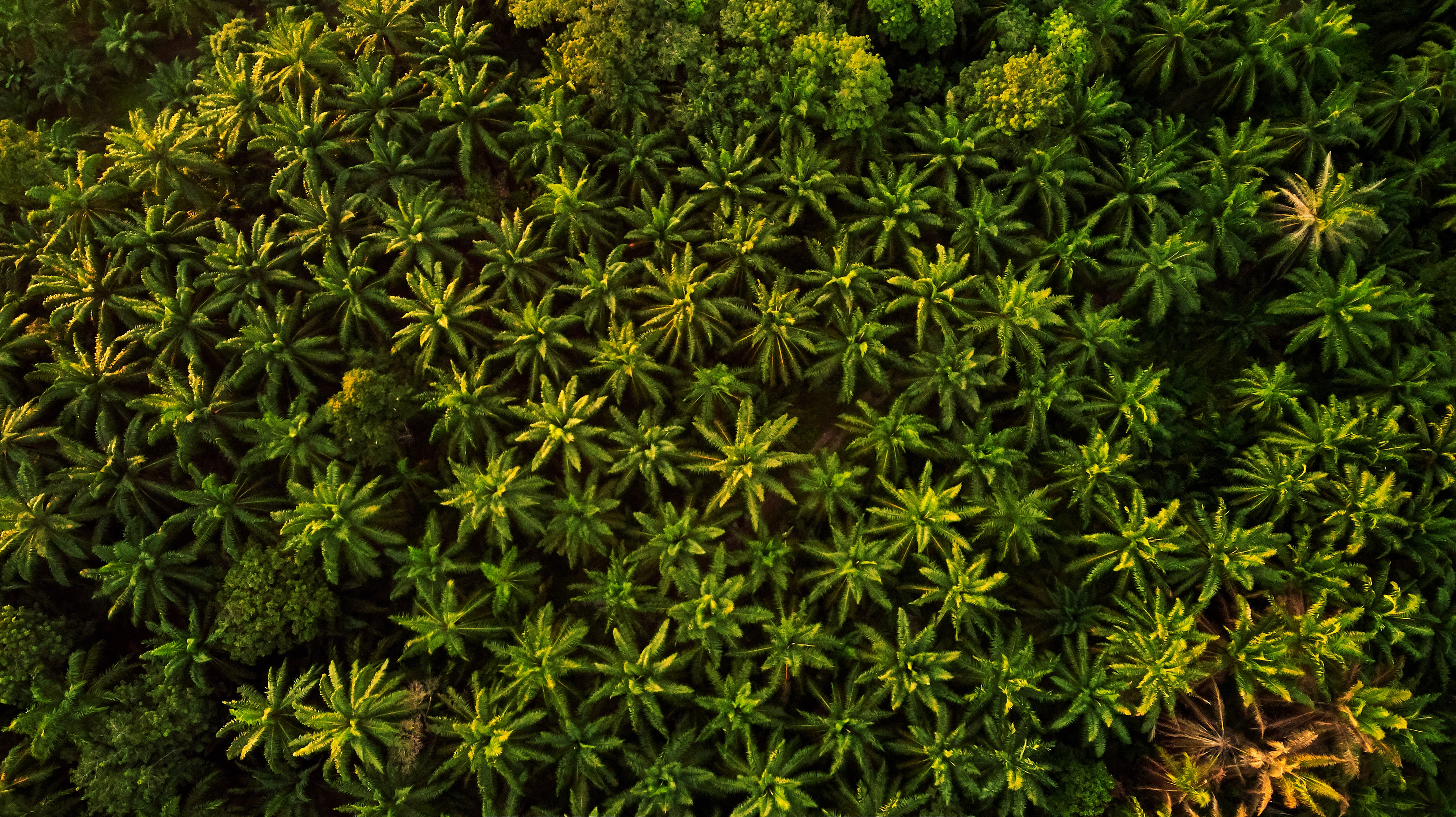
Belgium bans palm- and soy oil-based biofuels: Belgium’s Minister of Environment and Climate, Zakia Khattabi, recently announced that the country would ban biofuels within its borders made from palm and/or soybean oil by 2022. Denmark, France, and the Netherlands have all made similar announcements. The move signifies Belgium’s first step as part of its membership in the Amsterdam Declaration Partnership, a group of nine European countries which aims for “deforestation-free, sustainable commodities.”
We hope you’ve enjoyed this series! If you have any questions or things you would like to see as part of Good News Friday in the future, please feel free to contact us.
Environmentalist Rachel Carson’s famous book Silent Spring (1962) first brought public attention to organic contaminants such as DDT, a common insecticide that caused detrimental impacts to numerous ecosystems until its EPA cancellation order in 1972. Organic contaminants are a wide class of carbon-containing chemicals, encompassing familiar names such as glyphosate (RoundUp) and BPAs. They are created and discarded by human industry and are often transported into ecosystems through runoff water. To get a better understanding of modern research involving these contaminants, I interviewed Ian Bourg, Assistant Professor of Civil and Environmental Engineering and the High Meadows Environmental Institute. Professor Bourg leads the Interfacial Water Group at Princeton, which focuses on understanding the microscopic processes which occur when water is in contact with air, clay, and organic contaminants.

Why do you study processes at the microscopic scale?
Mostly what we’re doing is trying to understand the fundamental properties of matter, focusing on systems that are relevant to the environment – either in the natural environment or in engineered systems that are being used for protecting the environment. When a typical engineering group is doing work, they’re trying to design ways to manipulate the world and on the human scale to reach certain desired outcomes. Because many engineers work on the macroscopic scale, they use equations that represent the world at the macroscopic scale. In a lot of cases, we think that we can improve these equations if we gain more fundamental insight into how matter behaves at smaller scales.
Could you give a brief overview of your current research? What makes it interesting to you?
I’m interested in water in general because water is cool and water is important. Most water on the surface of the earth, or model that people are familiar with, is […] bulk liquid water, so like water in the ocean or in a glass. The properties of bulk liquid water are pretty well understood by now. Water near a surface remains kind of not that well understood, right? [For example] if I look at water near the water-air interface or near a solid surface or something like that, it changes its properties in various interesting ways depending on what’s on the other side of the interface.
The reason why we study clay is coming from our interest in water at interfaces, in that […] if you look at the average chemistry of the Earth’s crust, it’s mostly oxygen, silicon, and aluminum. There’s one way of packing together oxygen, silicon, and aluminum inside a crystalline structure that is apparently extremely stable and pretty close to the composition of the crust. That clay structure is a kind of structural motif that makes up half of the sedimentary rock mass, half of the mineral mass in soils, and about a third of the rock mass of the surface. If we’re interested in the interfaces between water and a mineral, most of it near the surface of the Earth would be water in contact with those specific minerals. So just kind of like by sheer abundance, if we’re interested in mineral-water interfaces, [clay] is the most logical one to be looking at.
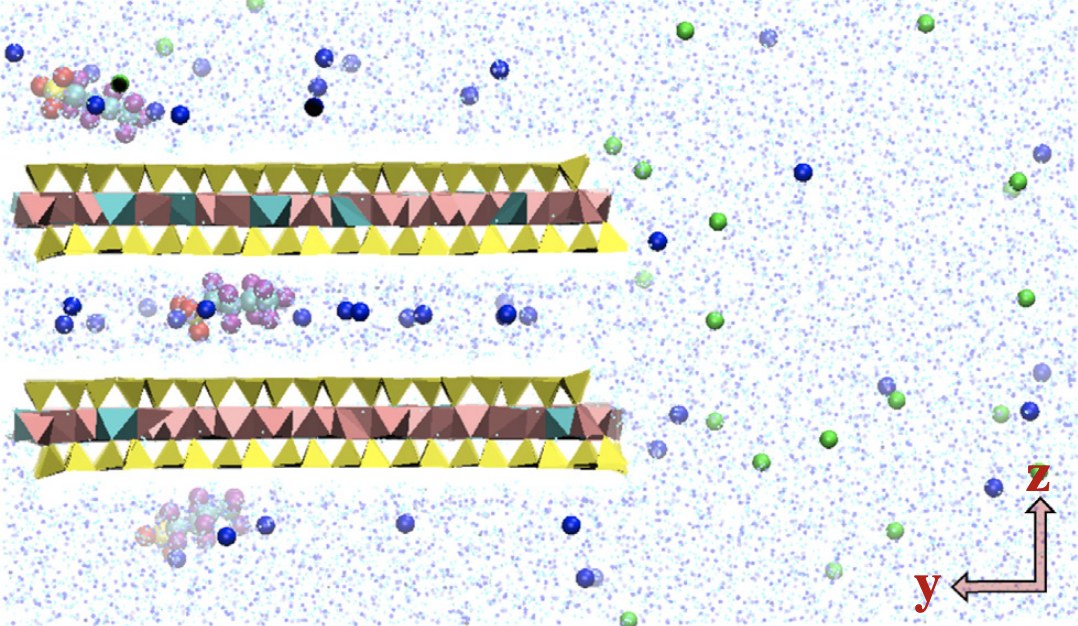
What are some common obstacles in removing or remediating contaminants in our natural systems?
My Ph.D. advisor always used to say that science doesn’t solve problems, it just replaces one problem with a different problem. It kind of seems a little bit bleak, […] but then, on the other hand, you’re just basically hoping that you’re replacing a big problem with a smaller problem, right? Organic contaminants that are present in natural systems tend to decay naturally with some kind of exponential decay, both through interaction with sunlight, like if they’re in a river or lake and also by being accidentally broken down by microorganisms. There’s some trickiness with that in that it often generates collections of byproducts or degradation products, that in some cases can actually be more toxic than the initial contaminant. A lot of engineered processes for removing contaminants from a system basically just remove them by transferring them to a different system. It doesn’t take [the contaminant] out of the system completely, so it’s always going to be there. Historically a lot of environmental engineering has kind of focused on protecting humans, basically preventing contaminants from coming into contact with humans, whereas a more sustainable approach would be actually removing contamination from the Earth.
What does sustainability mean to you?
I think sustainability to me means thinking about the entire lifecycle of some kind of environmental issue, I guess it’s easier for me to think of in terms of contaminants or carbon. I feel like sustainability kind of in a way also forces you to think more about natural processes. We try to focus on what we think are the most pressing kind of environmental concerns that humanity is facing, and often those happen to be concerns where [the] most pressing environmental issues are the ones where humans are clearly behaving in a very unsustainable way.
Are there any sustainability or climate science resources you know of that you would suggest for readers?
I did read Silent Spring six months ago and I was like this book is amazing! I don’t know why I didn’t read it before, you know. It’s also scary, but interesting.

One thing that I try to do in in CEE 207, the Intro to Environmental Engineering course, is to take a 10-minute break and talk about environmental news in like the major news outlets that that came out since the previous lecture. The Guardian has had a ton of really nice kind of environmental coverage for the last several years.
The time has come; It is the final stop on the Plant Based Food Tour of Princeton. This week we’ll be hitting up a variety of restaurants. We’ll give you our take on ice cream, pizza, and fully plant-based restaurants. Have you been curious about dairy free options at local ice cream shops, but still too nervous to take the leap? We will convince you! Wondering how pizza can be vegan? You’ll be surprised. Overwhelmed by all the different options at the local juiceries and plant-based restaurants? We’ll help you figure out what’s best for you. While this may be the final stop, we hope that we’ve encouraged you to continue to pick plant-based options when dining out in Princeton and wherever else you go. You can do something good for both your body and the planet!
Sweets
Thomas Sweet – Most Likely to Make You Feel Like a Kid Again
Price: $
Bang for Your Buck: ★★
Creativity: ★★★
Plant Forward: ★★
Taste: ★★★
Ease of Access: ★★★
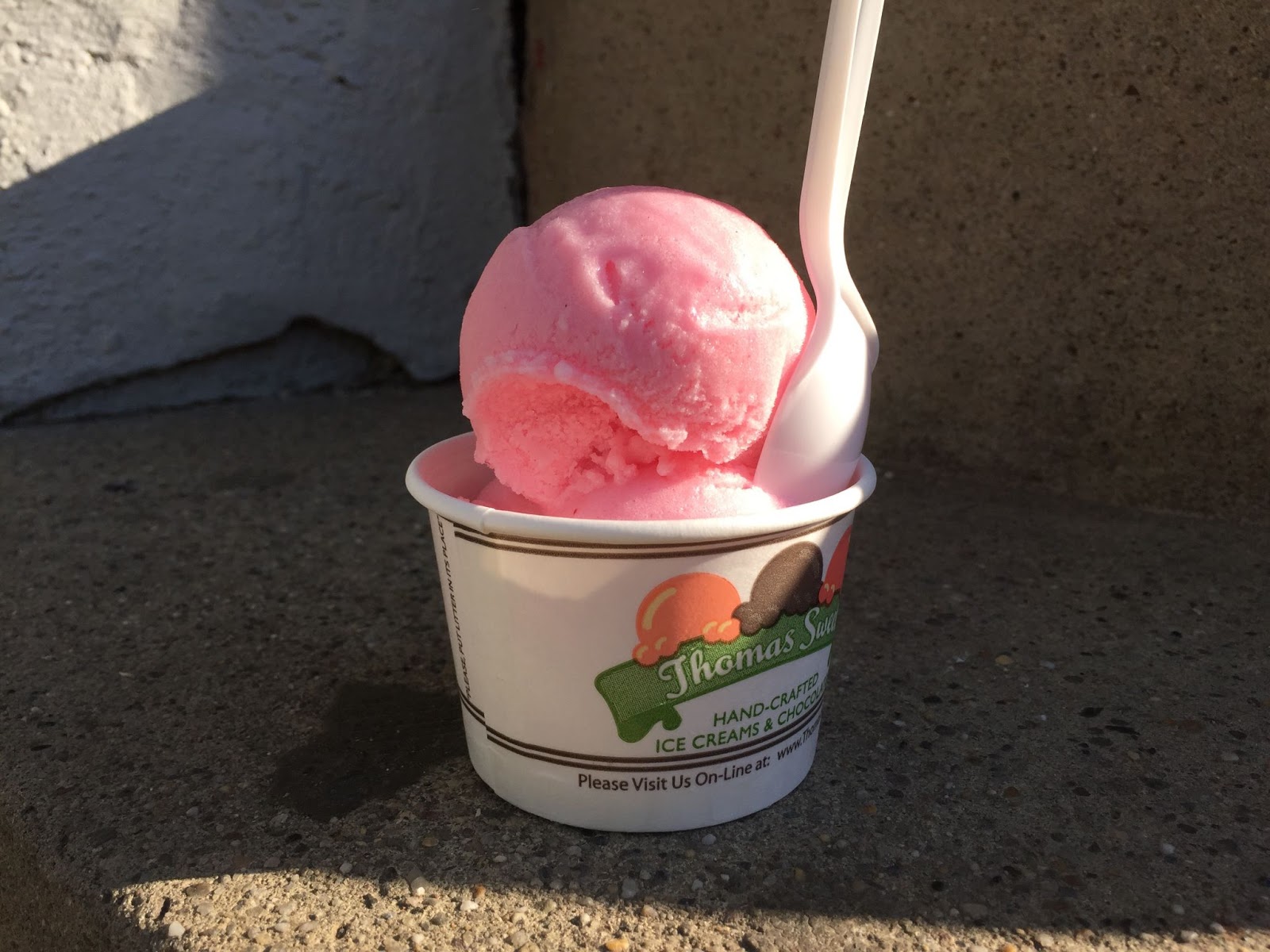
Thomas Sweet is most well-known for its blend-ins, which are a variety of toppings that you can get mixed with ice cream in a special machine to create a soft serve-like consistency. Because I wanted to sample the shop’s vegan options, however, I wasn’t able to get any of the flavors that were available for blend-ins. Their only vegan offerings were two flavors of sorbet: watermelon and pineapple. I ordered a single scoop of the watermelon, which I thought had a bit of an artificial candy-like flavor. The texture of the sorbet was quite enjoyable, though; I was expecting something like Italian ice and so was pleasantly surprised by how smooth it was. While Thomas Sweet may not be the best place to go if you’re looking for vegan frozen desserts, the blend-ins looked super fun, and I would definitely recommend giving them a try if you eat dairy. The store is not too far from campus and there are some outdoor tables right outside, perfect for a sunny outing with a few friends. I also loved how charming it was inside, with bright colors, whimsical decor, and even a funhouse mirror. Overall, Thomas Sweet is my ideal childhood ice cream shop with some creative twists!
Bent Spoon – Most Vegan-Friendly Ice Cream in Princeton
Price: $
Bang for Your Buck: ★★★
Creativity: ★★★★★
Plant Forward: ★★★★★
Taste: ★★★★★
Ease of Access: ★★★★
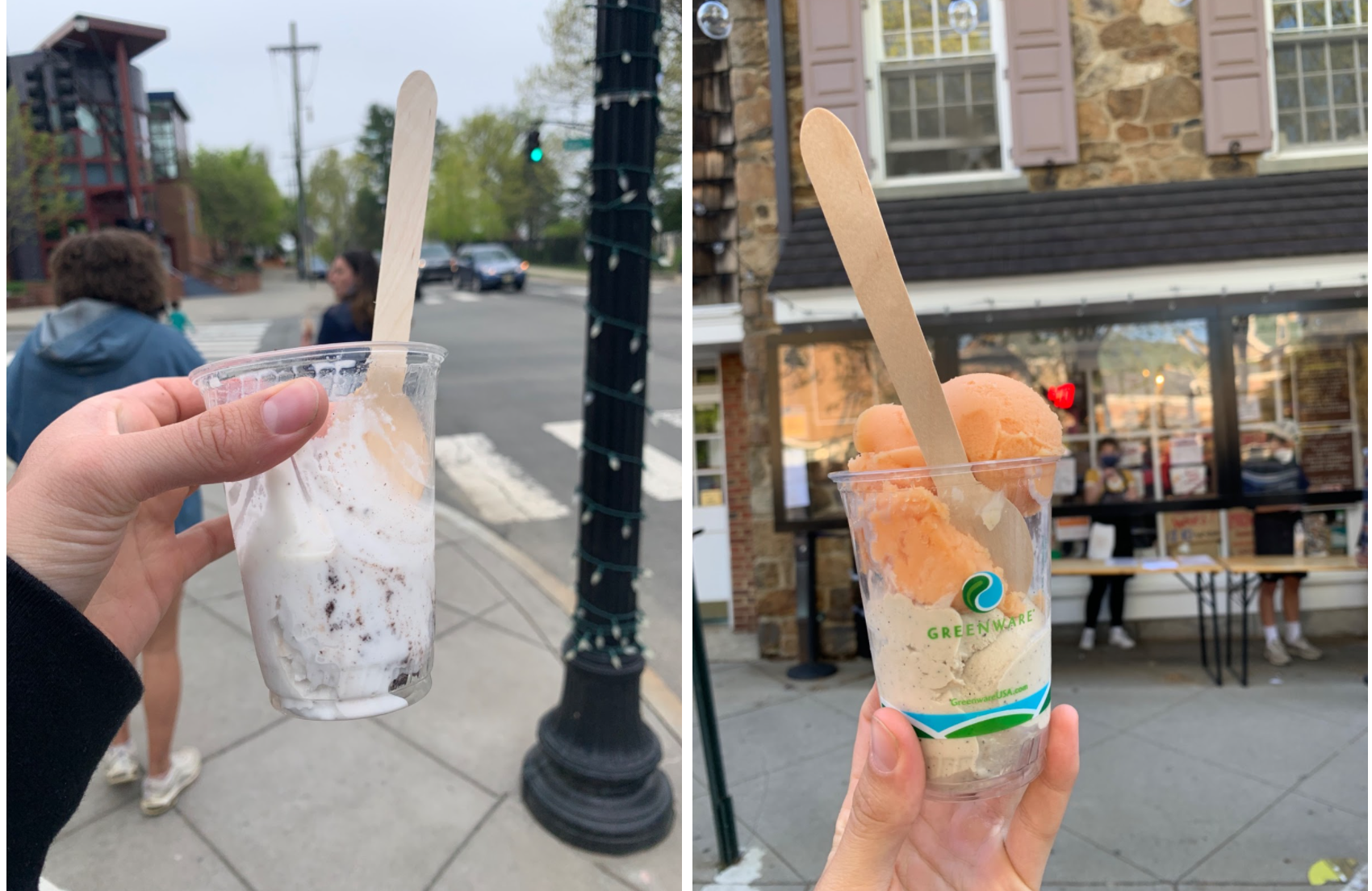
Bent Spoon will never fail to surprise you with their creative flavors. This holds true when it comes to their plant-based options. Their vegan flavors currently entail dark chocolate, raspberry, mango, organic coconut, cookies and cream, blood orange, and coffee coconut. I tried the organic coconut, cookies and cream, blood orange, and coffee coconut. I was thoroughly impressed with them all, but I think my favorite was the coffee coconut. Most ice cream shops typically only offer sorbets as their dairy-free options, so I love that Bent Spoon offers some more traditional, creamy/milky dairy-free options such as cookies and cream. Their creamier, more traditional ice creams seam to be coconut-based, so if you like coconut, this is perfect! They also hit it out of the park with sorbets if you are looking for a fruity, summer vibe. Regardless of what you’re in the mood for, if you are looking for plant-based ice cream, Bent Spoon has you covered.
Halo Pub – Creamiest Ice Cream in Princeton
Price: $
Bang for Your Buck: ★★★★
Creativity: ★★★★
Plant Forward: ★★
Taste: ★★★★★
Ease of Access: ★★★★
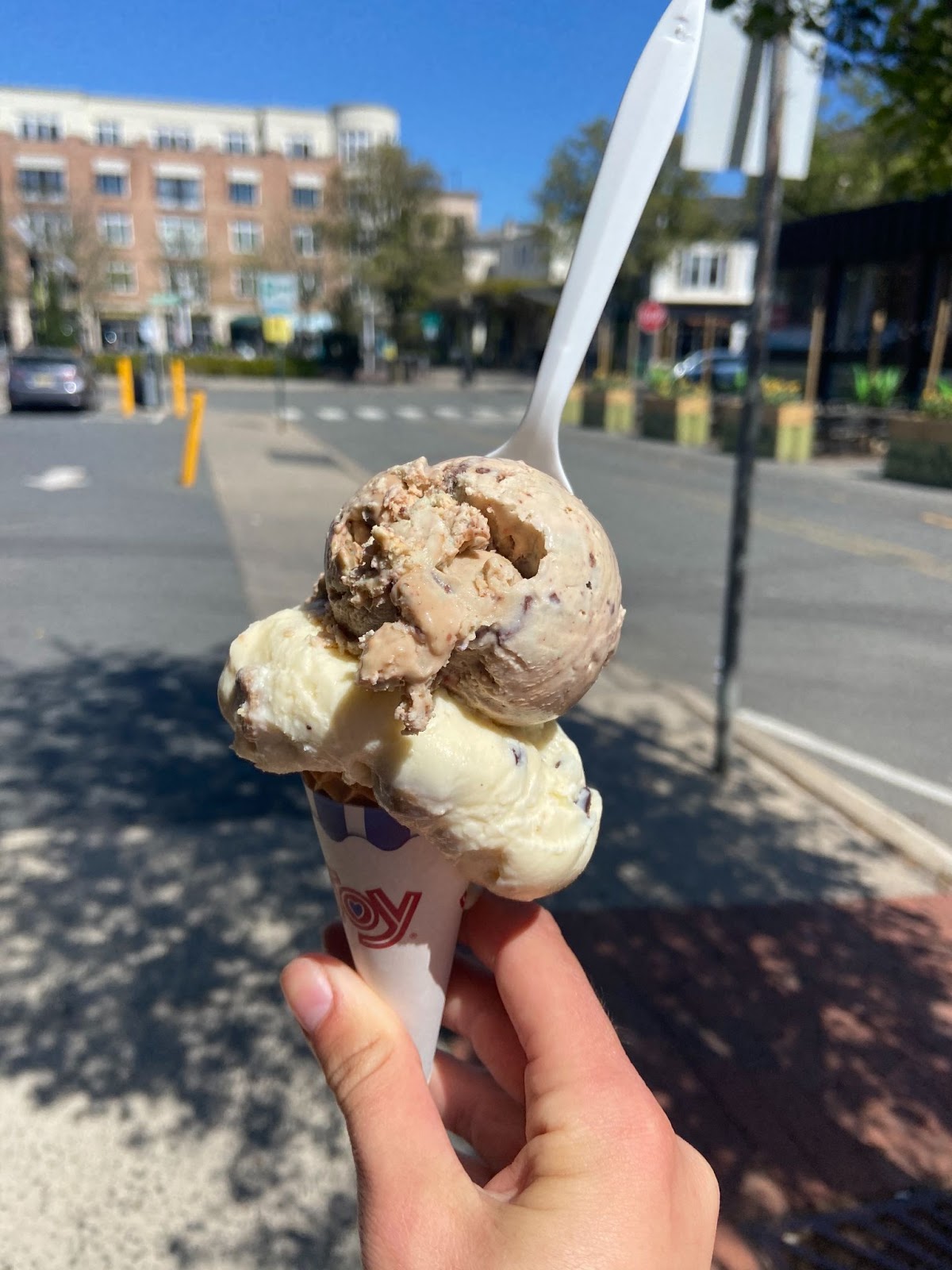
Overall, I had a really great experience at Halo Pub, but it did come with some disappointments for the vegan in me. I was disappointed to discover that their sorbets still had dairy in them and they were all out of their dairy-free flavors (but I will definitely return to try the dairy-free when they are back!). Because of this, I ended up ordering cookie dough and M&M ice cream which were both absolutely delicious! That said, as I’m writing this a couple hours later, I’m definitely having stomach pains. I would say the deliciousness was definitely worth it for me, but if you are more strict with your plant-based diet, be sure to go when their dairy free flavors are available!
Pizza
Jules Thin Crust – Most Likely to Challenge Your Notion of Pizza
Price: $
Bang for Your Buck: ★★★★
Creativity: ★★★
Plant Forward: ★★★★
Taste: ★★★★★
Ease of Access: ★★★★★

Jules Thin Crust doesn’t just provide your simple cheese pizza — indeed, they offer an impressive number of coded options and toppings from which you can choose! While many of their options are cheese-based or include meat, they also present several vegetarian and vegan-friendly options, including many no-meat pizzas, one vegan option, custom pizzas, and vegan cheese substitutes. After perusing their menu online, I ordered a mini Mexican pizza and a field salad with balsamic dressing. It took me just a minute to walk from the gates to pick up my food! The mini pizza was equivalent to about 2 slices of a large pizza, and at $8.25, was pretty good value for all the toppings you get: tomatoes, corn, scallions, cilantro, mozzarella, and chipotle sour cream, all on top of a delicious black bean spread on a crispy thin crust! Although the cilantro was a bit overpowering, the fresh tomatoes and sour cream really complemented the black beans well. The organic salad, albeit a bit pricey at $9.25, was well-sized and flavorful. The dried cranberries, apples, goat cheese, and balsamic were pretty standard additions but nonetheless delicious! Overall, I was pleasantly surprised by Jules’ Mexican pizza, and would definitely try their other special, non-cheese pizzas again.
Pizza Den – Most Plant-Friendly Pizza Place
Price: $
Bang for Your Buck: ★★★★
Creativity: ★★★
Plant Forward: ★★★
Taste: ★★★★
Ease of Access: ★★★
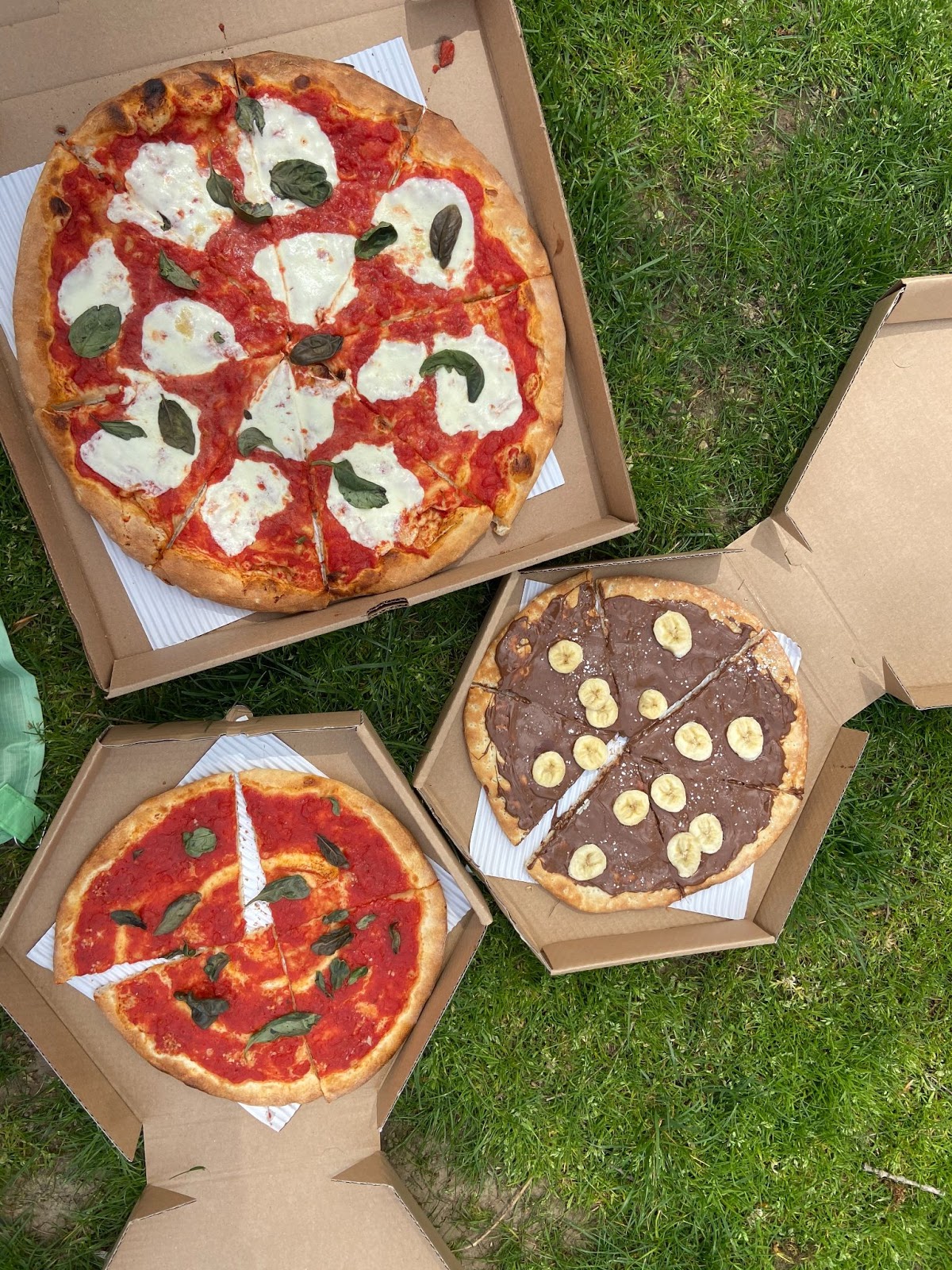
Overall, my experience at Pizza Den was really great. I ordered a Tomato Pie, which had no cheese, making it vegan and absolutely delicious! I also ordered the Brooklyn Pie which was even more delicious with a fluffy crust, a lot of sauce, and only small pieces of whole mozzarella (which is great for the plant-based eater like me who will eat cheese sometimes but doesn’t want so much that it will make her stomach hurt!). They also have the option to use daiya cheese (vegan cheese) which I love for the dairy-free and pure vegans out there! Last, I ordered the Nutella and banana dessert pizza. I’ve never had a dessert pizza before and I really enjoyed the sweet treat! I also ordered it all through Snackpass and was able to get a discount code so the ordering process was seamless and the price was right!
Fully Plant-Based
Fresca Bowl
Price: $
Bang for Your Buck: ★★★★
Creativity: ★★★
Plant Forward: ★★★★★
Taste: ★★★★
Ease of Access: ★★★★★
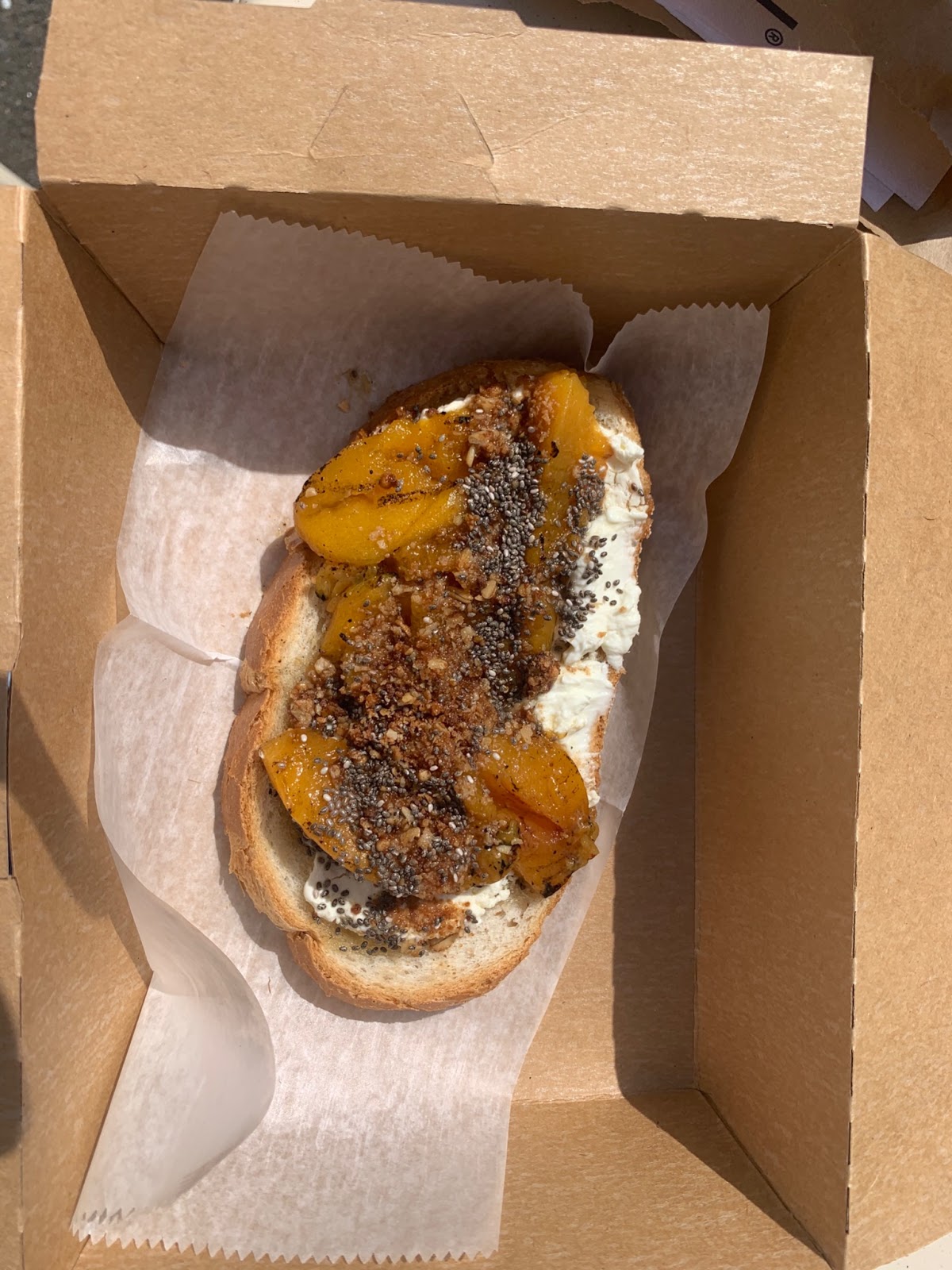
Fresca Bowl offers almost an overwhelming variety of options. Not only do they offer a variety of plant-based bowls (acai, pitaya, kale, chia, and oatmeal), but they also have smoothies, toast, salads, soups, coffee, and poke bowls. I tried the Fresca Acai bowl, the Pesca Noce toast, and Green Machine smoothie. The Fresca Acai bowl was not only delicious, but I was very satisfied with how large the bowl was. It was densely packed with fruits, granola, nutella, and acai, leaving me feeling very full. I feel that sometimes restaurants skimp out on the acai bowl, but Fresca Bowl certainly does not! They have a variety of toasts, both savory and sweet, but the Pesca Noce is a sweet toast with peaches, cream cheese, granola, honey, chia seeds, and cinnamon. It was also really filling and delicious. I highly recommend treating yourself for breakfast or even dessert with the Pesca Noce toast. Last but not least, I tried the Green Machine smoothie. Don’t be afraid to get your daily greens in; this smoothie was delicious and still pretty sweet, despite the main ingredients featuring both kale and spinach. Fresca Bowl is a great and convenient stop to get you plant-based fixings in and they have lots to offer. Maybe too much if you’re the indecisive type!
Playa Bowls – Most Colorful Smoothie and My Favorite Acai Bowl
Price: $
Bang for Your Buck: ★★★
Creativity: ★★★
Plant Forward: ★★★★★
Taste: ★★★★
Ease of Access: ★★★★

For the last stop on my plant-based food tour, I went to Playa Bowls. There I got a Pura Vida açai bowl and a pitaya smoothie. The açai bowl surpassed my expectations. It had the sweetness of honey, fruitiness of açai, blueberries, and strawberries, and the crunch of delicious granola. It was nicely cold and I recommend it. The smoothie didn’t quite meet how delicious it looked. Being a bright pink pitaya mixture, I expected lots of fruity flavor. What I got was nicely creamy, but not very flavorful. It was very far from the sweetness, acidity, or kick usually present in a good fruit smoothie.
I love the inside of Playa Bowls. It is located on Hullfish Road next to Lan Ramen and down the street from the public library. I was asked whether or not I wanted a bag and I did not receive any unnecessary plastic or waste. The plastic smoothie cup claims to be made of recycled plastic and the shop advertises their commitment to reducing waste. I recommend ordering the Pura Vida or another açai bowl the next time you go to Playa Bowls.
Tico’s – Most Fantastically Fruity Flavours
Price: $
Bang for Your Buck: ★★★★
Creativity: ★★★★
Plant Based: ★★★
Taste: ★★★★★
Ease of Access: ★★★★
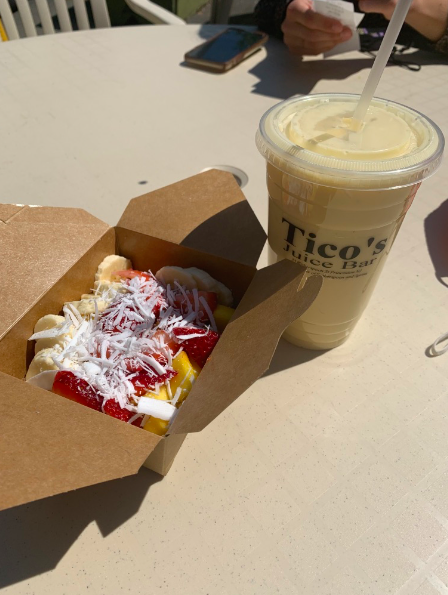
Got a sweet tooth? Love you some fruit? Want to combine the two? Look no further than the astounding establishment that is Ticos! Located on Spring Street, Ticos is a Princeton town stalwart that is totally worth your time. For this review I ordered their Pina Colada smoothie and the Sweet Thing organic bowl, both of which were packed with fruity goodness and left me very satisfied long after the food had disappeared. I have never tried a smoothie bowl with a guava base before and the Sweet Thing bowl really impressed me. The Pina Colada smoothie is my go-to when ordering at Tico’s and I cannot rave about it enough. The menu at Tico’s is mostly fruit items, but you can order quesadillas as well. There is a large range of plant-based options, but keep in mind that all of their smoothies contain yoghurt, so if you are searching for a wholly vegan option you will have to ask them to substitute the yoghurt for ice. I have never had a bad experience at Ticos and I doubt you will either; go on… Check it out!
Planted Plate – Most Plant-Based Plate in Princeton
Price: $$
Bang for Your Buck: ★★★★
Creativity: ★★★★★
Plant Forward: ★★★★★
Taste: ★★★★
Ease of Access: ★★★★★
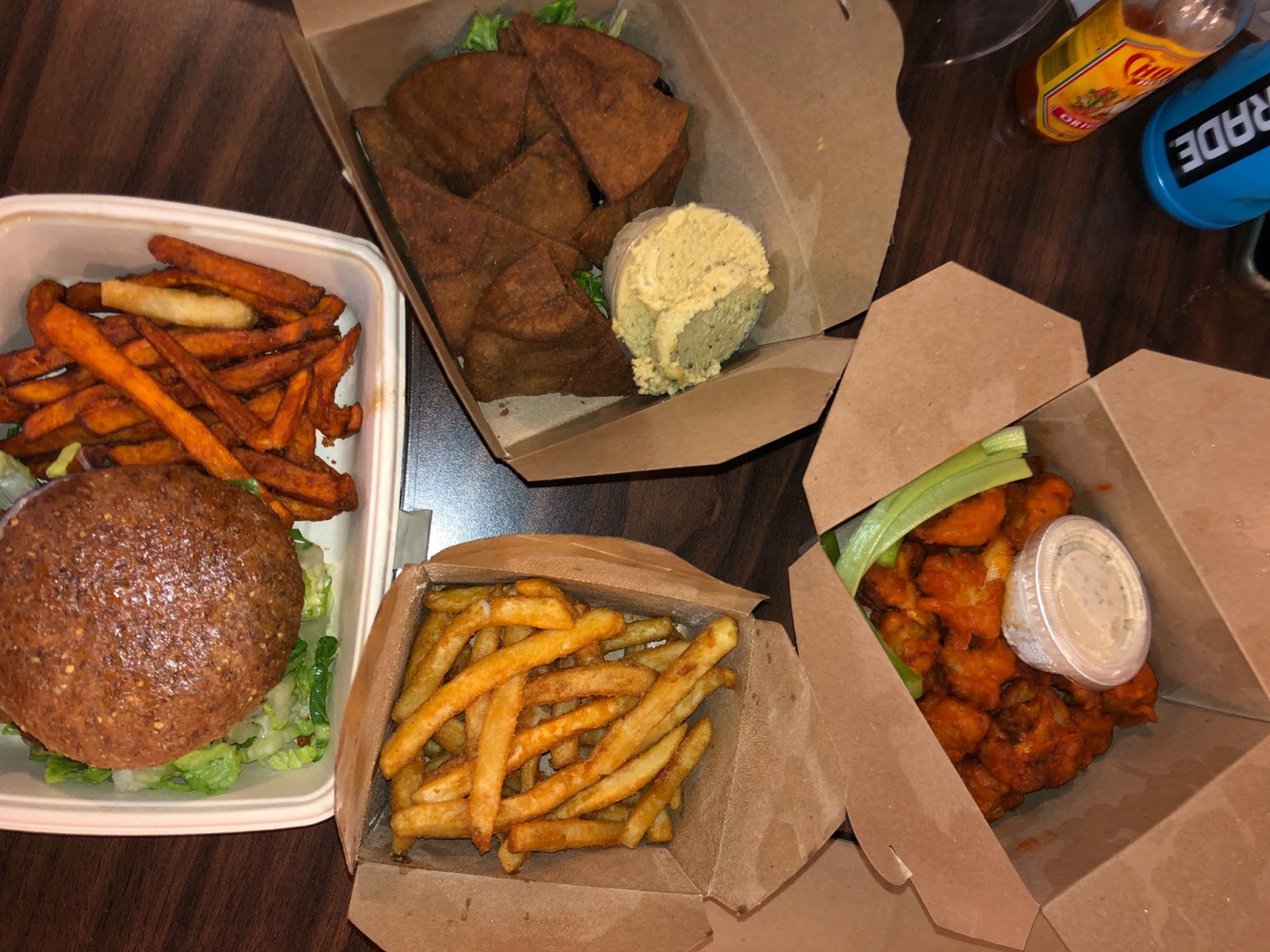
Wow. So many plant-based options to choose from. My personal favorite was the cauliflower bites. They would certainly satisfy a buffalo wing craving anyday. The vegan ranch was also a wonderful dipping sauce. I was surprised by the pitas served with the hummus; they were warm and both crispy and soft. 10/10 would recommend. The main dish I had was the cali burger, which was good, but a little dry. The bread and toppings were, however, very fresh and I felt like I was eating good, quality ingredients. Hot take: Planted Plate has the best french fries in Princeton. I also learned that if you’re on snack pass you can get 25% your first order at Planted Plate and if you’re a student you can get 10% off anytime!
Arlee’s Raw Blends – Best at Making the Ingredients Shine
Price: $$
Bang for Your Buck: ★★
Creativity: ★★★★★
Plant Forward: ★★★★★
Taste: ★★★★
Ease of Access: ★★
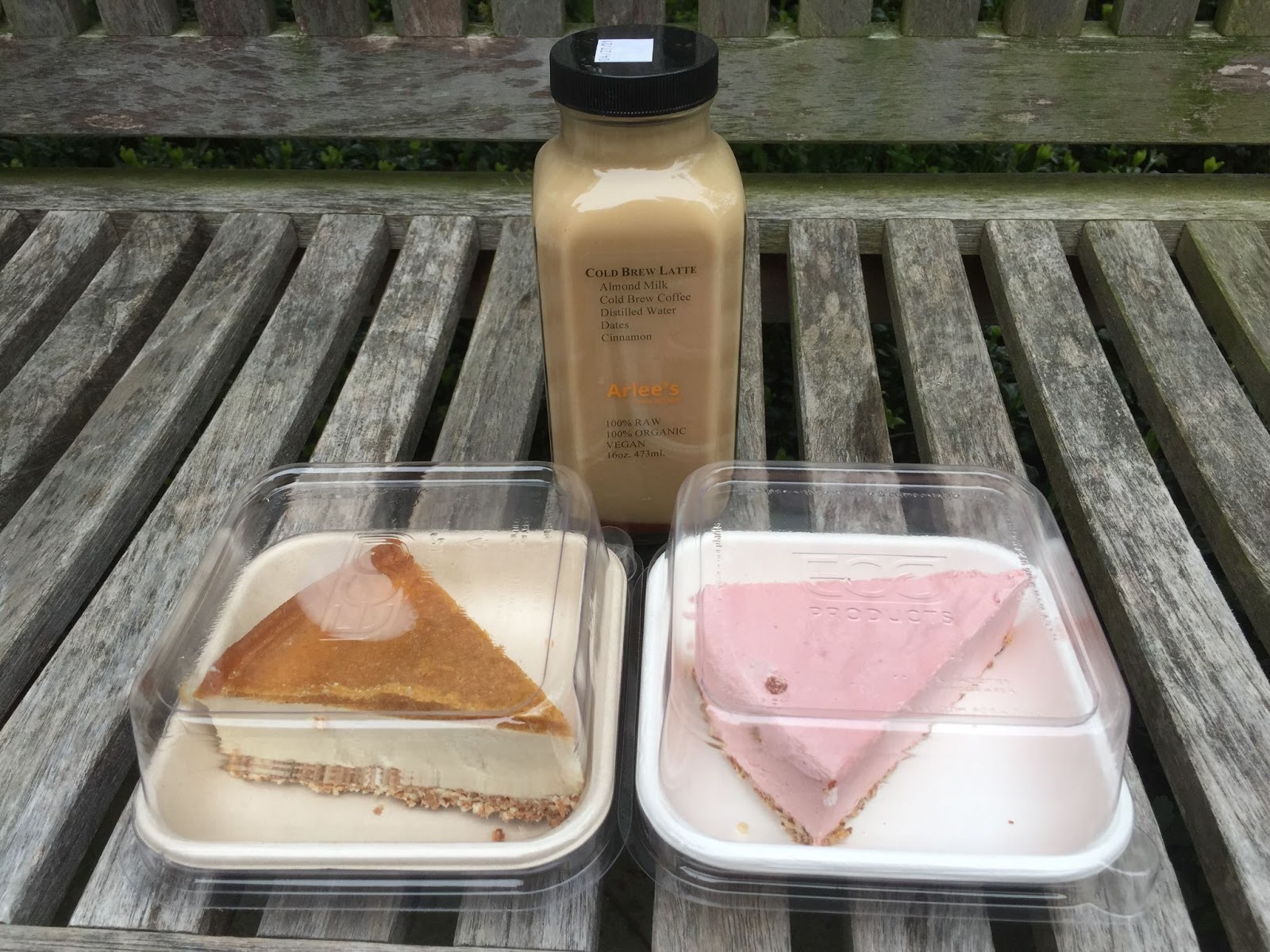
While the focus at Arlee’s might be on juices, don’t be deceived—they have a surprising amount of variety in their menu items, including breakfast items, wraps, salads, snacks, desserts, and even pizza. Furthermore, everything is completely plant-based! My sweet tooth was calling and I was especially enticed by their plant-based cheesecake, so I ordered two slices, one strawberry and one mango. For my daily caffeine fix, I also got a cold brew latte made with almond milk. As a big fan of fruity desserts, the cheesecake was right up my alley. It was lighter than traditional cheesecakes but still had a nice tang, and the crust made from raw almonds actually resembled a graham cracker crust more than I expected. I personally liked the strawberry better than the mango, but would happily take another slice of either! One note is that you should avoid letting the cheesecake sit for too long—I left it at room temperature for a few hours before finishing it, and the texture softened a lot once it was no longer chilled. The cold brew latte was sweet but refreshingly so, with a pronounced cinnamon taste. It did seem a little watery to me, especially because I tend to like strong coffee drinks. That being said I finished it easily (and also loved the glass bottle it came in!). One drawback is that the items at Arlee’s can be quite pricey ($8.99 for each slice of cheesecake and $10.99 for a 16oz. latte). While perhaps not affordable on a regular basis, and also a little far from campus (near Hoagie Haven), the quality of the ingredients at Arlee’s and its exciting plant-based menu make it a great place for a special treat.

*** We are not food critics, but food enthusiasts. This is in no way intended to be a formal critique or review of any restaurant in Princeton, merely a way to encourage students to try more plant-based options when dining out.
Author: Maddy Chong ’23
Recycling is often hailed as “the consumer’s solution to climate change,” and companies tout their sustainability focuses, emphasizing “recyclability” and “going green.” In truth, however, recycling is a deeply flawed system, and we are quickly seeing the consequences of its limitations.
Plastics are particularly difficult to recycle and can cause confusion when we ask ourselves “Which bin does this go in?” One especially confusing aspect is the (in)famous recycling sign. Found on nearly every plastic item, one of the most common sustainability myths is that anything with the recycling sign can be recycled. In this article, we’ll dive into the history of the symbol, what it really means, and why we have to watch out for greenwashing.
The History
In 1970, in response to a design contest for the first Earth Day, college student Gary Anderson designed the Universal Recycling Symbol (URS).
The contest was sponsored by the Container Corporation of America (CCA), a company producing recycled paperboard and interested in raising awareness of environmental issues. Anderson won a scholarship prize for his entry, and he explained that the symbol was inspired by the Mobius Strip, a figure made with a folded strip of paper, creating a single continuous edge. This symbolized the idealistic version of recycling in which items are held infinitely in a circular economy. While the CCA modified the symbol slightly from Anderson’s submission, the design is now widely recognized.
The issue, however, is that in 1988, the US Society of the Plastics Industry developed something called the Resin Identification Code (RIC) system. The purpose of this system was to simplify recycling of plastics for programs across the US by differentiating the different types; each type has to be recycled separately from the others to ensure success. The way they chose to portray this information is by placing a number, 1-7, within a simplified version of the URS, and each number corresponds to a different type of plastic.
Immediately, we see a problem emerging; a system used to identify plastics (which aren’t all recyclable) uses a sign that signifies that something is recyclable.
Meanwhile different variants of the symbol were also developed, with some indicating that something is recyclable, others that the item is made of recycled materials, and still others emerging.
The invention of the RIC system, combined with the development of different variations of the symbol, has today created a complex, confusing knowledge system. What started off as a seemingly simple idea has now been co-opted and actually makes recycling more difficult for American consumers.
So why is this a problem?
The biggest problem is contamination. This occurs when recycling is done incorrectly and can arise from trying to recycle things that are dirty, made from an non recyclable material, or otherwise not sorting things correctly. Contamination is a huge problem in the recycling industry, and it is time consuming and inefficient to sort contaminated bins, so they are often just sent to the landfill as trash.
In addition, even when done correctly, plastic is always downcycled. What this means is that it loses value every time that it is recycled. So, after only 1 or 2 goes, even the most recyclable plastics have to be turned into a final, nonrecyclable product. Thus, the need for virgin plastic isn’t stopped by recycling and is slowed at best.
There is also very little demand for post-consumer materials. Transporting and recycling materials (even when they are not contaminated) is inefficient and costly, so it is often cheaper to just use virgin materials. This is why many types of plastic (think 3-7) are rarely accepted – there is just no monetary incentive to do so. This problem is further emphasized by the fact that the US can no longer ignore our problem and sell waste to other countries.
On an individual level, recycling is also difficult. Companies have caught on that more and more people are looking for sustainable options. However, instead of opting for sustainable practices, many have just turned to greenwashing. This is the concept of using symbols like the color green, plants, or the words “environmentally friendly” on marketing. Now, to determine if something is actually sustainable, consumers have to research and invest time into their purchasing choices. Not everyone is willing to do this, and corporations get away with branding their products as something they aren’t.
Recycling standards also change by location and time, so people must stay up to date and informed to recycle properly. Changes often aren’t communicated broadly or clearly, and this leads to further contamination in our recycling streams.
So what now?
The state of affairs seems gloomy, certainly. But, recycling isn’t a completely moot point. By improving the system we currently have while also developing and working towards something better, we can collectively work towards brighter futures.
The first step is moving away from plastics in general. Decreasing our use will not only reduce how much is sent to be recycled (and later landfilled), but also lower demand. Plastic is made from oil, after all, so it is in our favor to produce as little as possible. Finding alternatives is a big part of this.
On a personal level, find reusable versions of the most common single-use items. Things like utensils, dishware, and cups are some of the most common products made from plastic (and usually aren’t recyclable due to food contamination). On a larger scale, encourage research into alternatives and support legislation that focuses on plastics/recycling to help shift our society away from our plastic reliance.
Once we’ve started to eliminate unnecessary use, paying attention to what we do have to use can help reduce contamination. This requires learning about whether products are actually recyclable and/or sustainable and not falling prey to companies looking to make money. One resource that makes this especially easy as a Princeton student is the Recycling App. Supported by the Office of Sustainability, students can look up most items to determine if and where they can dispose of specific items. Many cities have similar guidelines online, available to residents looking to be informed about the practices in their hometowns.
As consumers, we have a responsibility to learn about what happens to the products we use and to play an active role in improving the system we live in.
Author: Grace Liu ‘23
Welcome again to another Good News Friday! The semester is coming to a close, and we hope that we’ve been able to brighten your weeks in a small way. For this edition, we will read about an Indigenous victory relating to protecting salmon populations, the new EPA stance against environmental racism, and Elon Musk’s latest and greatest battery farm.
We hope you’ve enjoyed the stories this week. Check back next time for more encouraging environmental news. If you’d like to share some Good News with us, please feel free to get in touch!
Welcome to the fifth stop on our Plant-Based Food Tour of Princeton, and definitely the one a lot of us were most excited for! This post will be your ultimate guide to deciding where to beg your parents or significant other to take you out to dinner, while also keeping the plant-based diet in mind! We’ve discovered that even at a steakhouse, you can still eat plant-based. We hope this post inspires you to both treat yourself and the planet with these high-end plant-based options.
Agricola Eatery – Most Plant Forward
Price: $$$
Bang for Your Buck: ★★★
Creativity: ★★★★★
Plant Forward: ★★★★★
Taste: ★★★★★
Ease of Access: ★★★★★
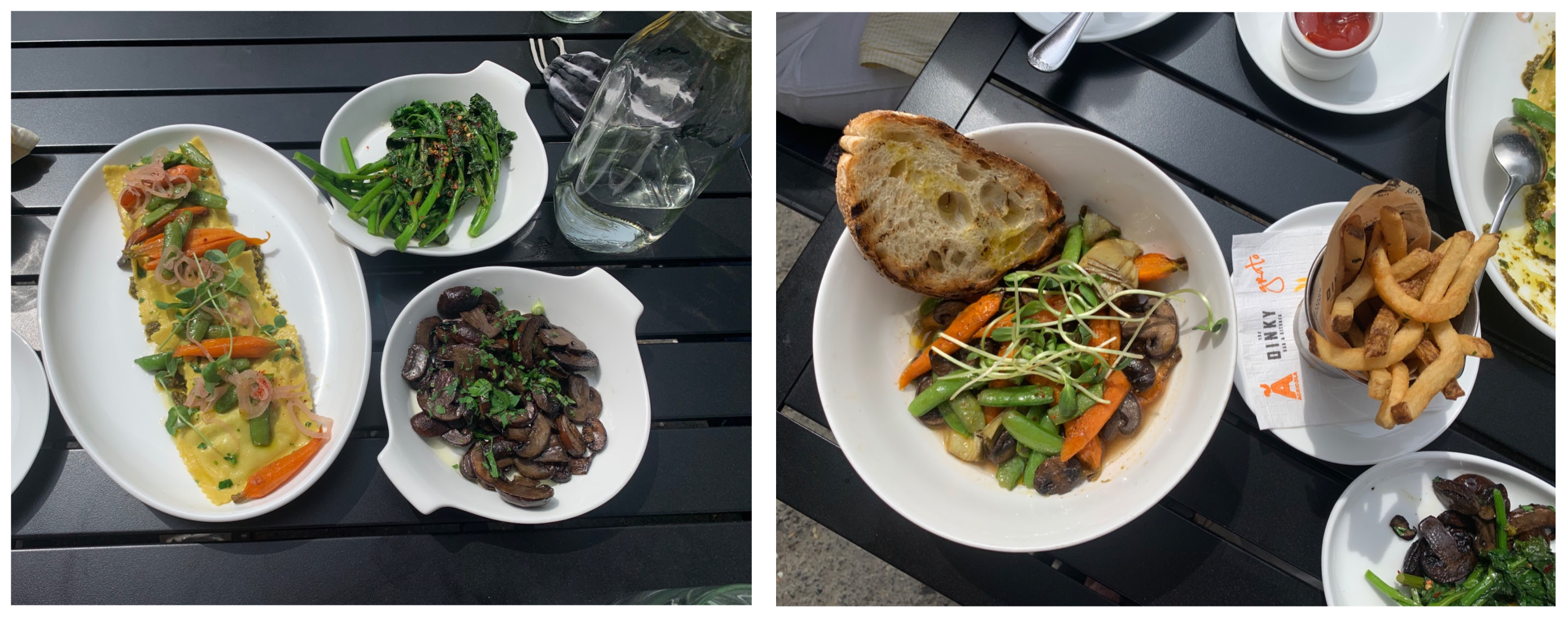
It is probably safe to say that Agricola is the most plant-forward of the high-end restaurants in Princeton. I went on a beautiful sunny day and enjoyed their outdoor seating on Witherspoon St. I tried their two entrees that they note as being “inspired by the cultural shift towards sustainable, plant-based eating.” To say that I was thoroughly impressed is an understatement. The LoRe Pea Ravioli featured several veggies such as carrots and peas, used a very creative pea filling, and was topped with an almond pesto. The Spring Vegetable Barigoule was a delicious soup with peas, carrots, mushrooms, and artichokes as well as sourdough bread. Both entrees exceed my expectations by far. They were completely plant-based, tasty, and filling.
I also tried the Roasted Local Mushrooms, Broccoli Rabe, House-made Fries, and Avocado as sides. They were all fantastic. The fries were the perfect balance of fresh and fried, the broccoli rabe had a nice kick to it, and the avocado was light and simple. The Roasted Local Mushrooms were the star of the sides, though. They were hands-down the best mushrooms I have ever tried. Overall, this meal was very tasty and, most importantly, extremely plant forward. Oftentimes, vegetarian options at restaurants are very dairy heavy. I loved how creative Agricola was with their plant-based options and loved that they were fully plant-based. Agricola is helping lead the cultural shift to healthier and more sustainable diets!
Winberies – Most Surprising Plant-Based Creativity
Price: $$
Bang for Your Buck: ★★★★
Creativity: ★★★
Plant Forward: ★★
Taste: ★★★
Ease of Access: ★★★★★
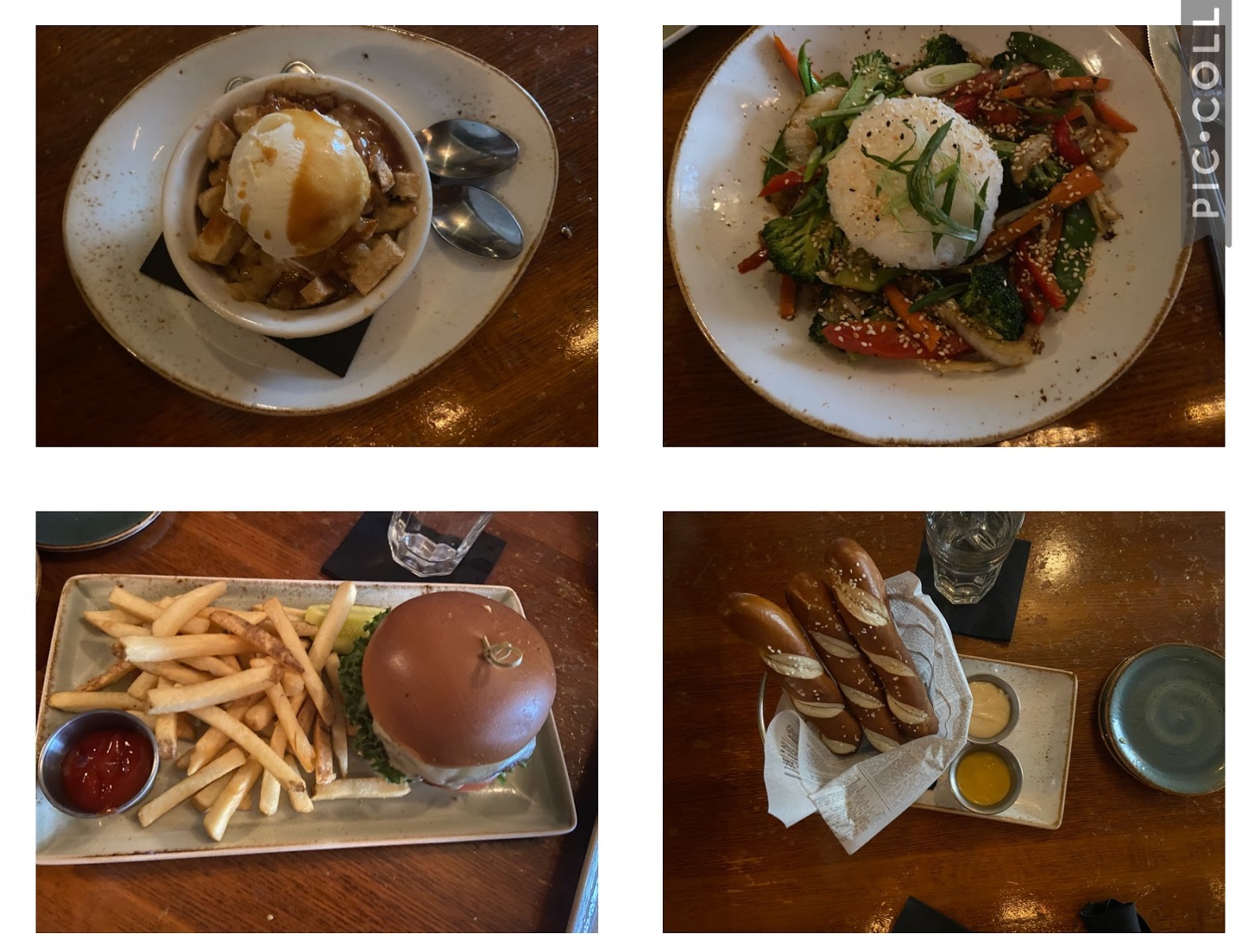
For the type of place that serves bar food, I was really surprised with the amount of plant-based options Winberies has to offer! Most places have plant-based appetizers and salads, but Winberies actually had two entrees that I could order! For an appetizer I ordered the beer baked pretzel sticks. It came with three large sticks, which I thought was decent for the $9 price, and they were super fluffy and salty. The perfect appetizer! For entrees, I ordered the veggie rice bowl and the housemade vegetarian burger. While I think the veggie rice bowl could’ve had more flavor, I was really impressed with how many vegetables were included in the bowl and how light the entree was. Typically, restaurants like this tend to make things super heavy, but the veggie rice bowl was delightful and felt good to eat! Most innovative was the housemade vegetarian burger. The burger was made out of portobello mushrooms, brown rice, oats, and beets, and had a really shocking look and consistency. It honestly looked like a real burger and gave a beyond burger vibe but with whole vegetables instead of the scientifically created beyond meat. The burger was definitely mushier than other veggie burgers I’ve had but was really exciting to try and tasted pretty good! Last, but certainly not least, was the apple crisp for dessert. The dish had diced apples warmed up with rum caramel sauce, hazelnut streusel, and vanilla ice cream. How could you go wrong?
Overall, Winberies really surprised me with their thoughtfulness for plant-based eaters and I would not hesitate to go again with some friends!
Witherspoon Grill – Fanciest Restaurant With the Best Bread
Price: $$$
Bang for Your Buck: ★★★
Creativity: ★★
Plant Forward: ★★
Taste: ★★★
Ease of Access: ★★★★
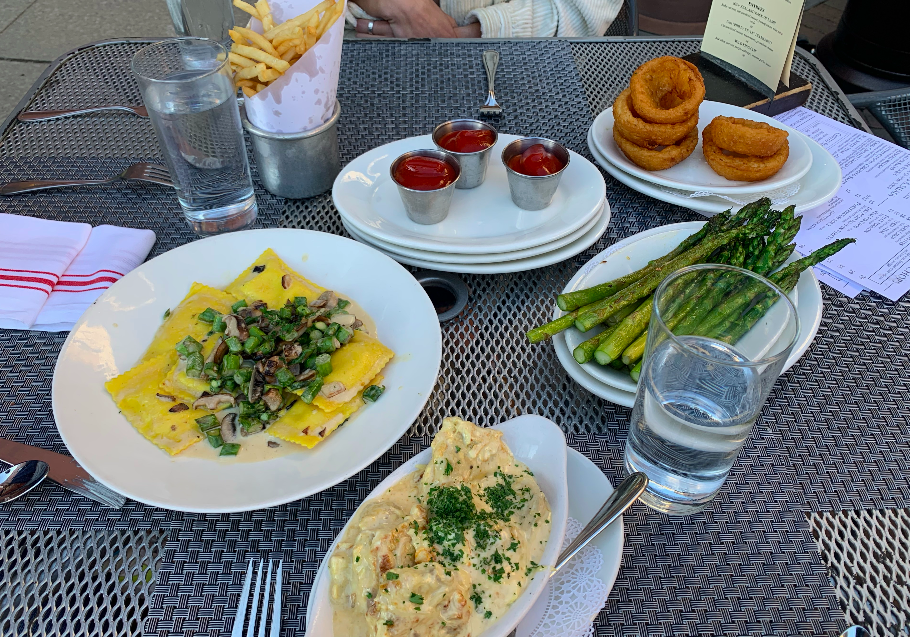
Witherspoon Grill is located in Hinds Plaza in the centre of downtown Princeton. The restaurant has a large outside eating area for the summer months, and impeccable service. Make no mistake: Witherspoon Grill is a restaurant committed to serving meat, and as such their plant-based options are thin. I ordered most of their non-meat options: Fries, Onion rings, Artichoke Francaise, Asparagus, and the Ricotta Ravioli. A veritable feast. While all of these options were really tasty, they were mainly appetizers, and the only entrée option that was in any way plant-based was the Ravioli. The star of the main meal was undoubtedly the artichoke francaise, however the sauce was a little thick and I left feeling extremely full. This was possibly contributed to by the fantastic desserts: flourless chocolate cake and peanut butter lava cake. Ultimately, I would encourage you to eat out at Witherspoon Grill, but keep in mind that you are going to be limited on creative plant-based options. Oh and one last thing: their bread is fantastic!
Mediterra – Most Fresh Ingredients
Price: $$$
Bang for Your Buck: ★★
Creativity: ★★★
Plant Forward: ★★
Taste: ★★★★
Ease of Access: ★★★★
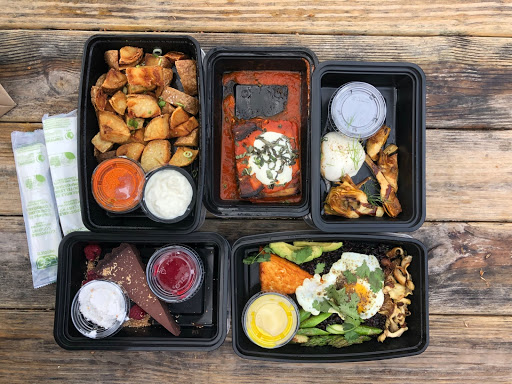
Mediterra did not have many options that did not include meat or cheese. I tried the Pasta-less lasagna which was flavorful and featured some fresh eggplant, but the portion was very small for the $25 cost. The Market Bowl was tasty and a fun mix of different vegetables. One the side I tried the papas bravas and burrata with fried artichoke. The papas bravas was definitely the best bang for your buck item in terms of plant-forward options at Mediterra (only $8). Without it I definitely would have left hungry. The fried artichoke was fun to try, but the portion size was quite small and the flavor of the artichoke was hidden by the frying method. I was pleased with the chocolate ganache tart as dessert. The rich chocolate tart was complimented well by the coconut crema and raspberry sauce. Overall, I enjoyed the food, but it was unsatisfied with the small portions for a big price. It was clear the ingredients were fresh, which was a plus.
Local Greek – Most Comprehensive Platter
Price: $$-$$$
Bang for Your Buck: ★★★
Creativity: ★★
Plant Forward: ★★★
Taste: ★★★
Ease of Access: ★★★★
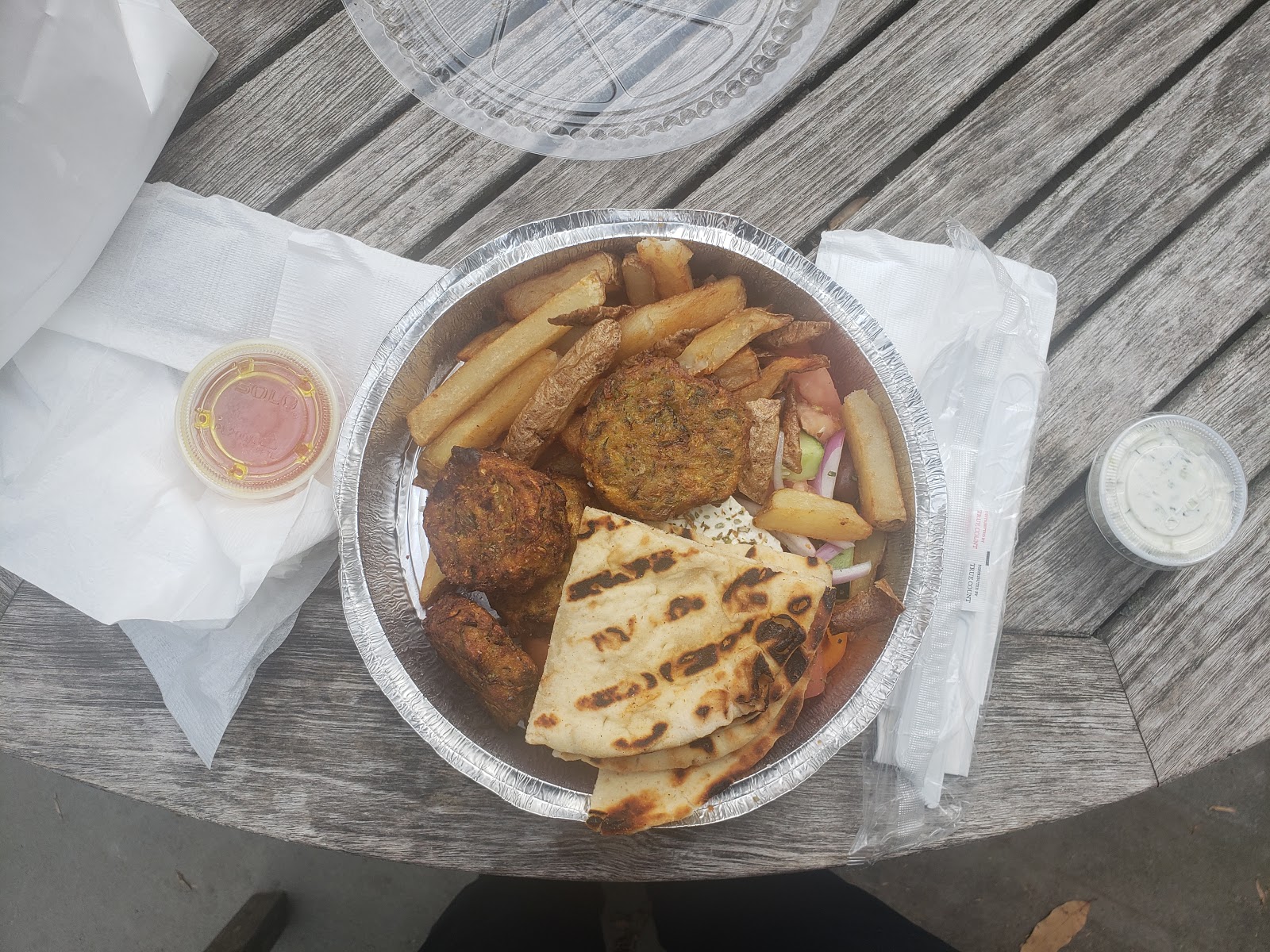
For week 5 of the Plant-Based Food Tour, I ate at Local Greek. This restaurant has its main location a 12 minute walk from Fitzrandolph Gate. It also has a location with takeout and very limited outdoor seating on Nassau Street reviewed last week. Over two trips, I tried two entrees, a side, and a salad.
The first entree I tried is the Greek Falafel Platter, which is a vegetarian option. This falafel was good, but it didn’t set itself apart from other falafels. The accompanying tzatziki sauce improved this and made the falafel less dry. This platter also comes with a small salad, some pita bread, and a choice of rice or fries. I enjoyed the salad, but like the falafels, it didn’t impress me too much. The fries and pita were fine, if standard.
The second time I ate from Local Greek, I decided to try something new. This was the Gigantes entree, described as large lima beans in a Greek herbed tomato sauce. As seen in the picture below, this is the dish that made my desk look like a bit of a crime scene (presumably because it tipped and spilled during my walk home). I quite enjoyed the warmth of this dish and the heartiness of the lima beans however. Because I am not familiar with this dish, I don’t know if the oily quality of the sauce is typical, but know that this is how the dish was for me.
Lastly, I tried the Horiatiki salad and the hummus. The salad was fine; I appreciated the feta cheese, but the dressing didn’t add much and there was little else done to the cucumbers, tomatoes, onions, and olives besides being sliced up. The hummus tasted pretty standard as well, though I appreciated the chunkier texture of the chickpeas.
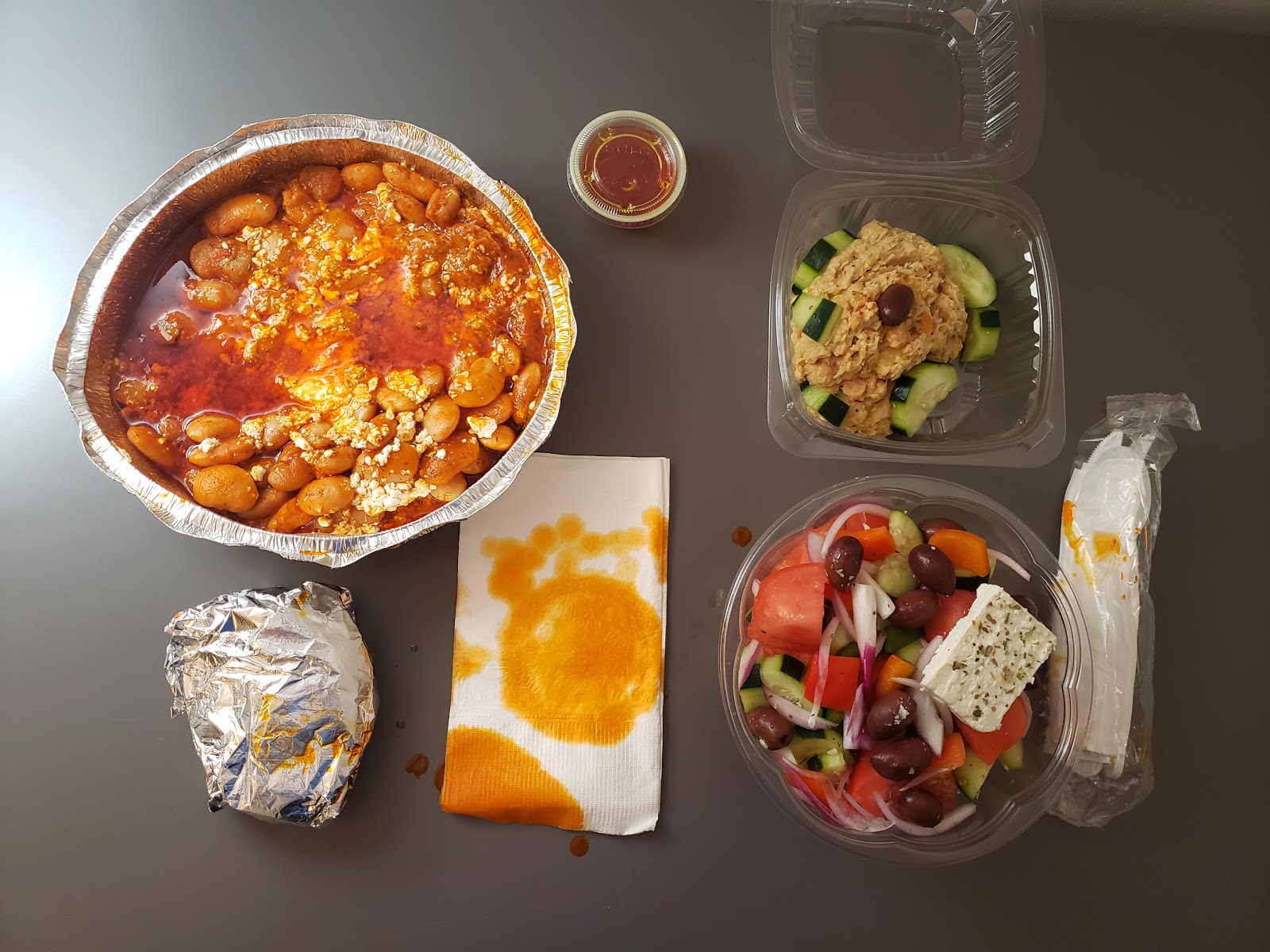
Local Greek is located at the intersection of Leigh Ave and John St with a satellite location on Nassau St. The restaurant offers limited indoor dining, takeout, and outdoor seating. There is a good amount of plant-based options on the menu and they are clearly labelled with “vg” for vegetarian and “vn” for vegan. Order the Greek falafel platter for a solid plant-based entrée with a side of fries and a small salad.
La Mezzaluna – Most Welcoming High-End Restaurant
Price: $$$
Bang for Your Buck: ★★★
Creativity: ★★
Plant Forward: ★★
Taste: ★★★★
Ease of Access: ★★★★

After seeing rave reviews for the rigatoni vodka at La Mezzaluna, I had to give it a try for myself. I certainly wasn’t disappointed—I especially loved the sauce, which was rich, creamy, and slightly sweet (would recommend using it as dip for the complimentary bread!). I was even able to sub whole wheat penne for the rigatoni at no additional cost, which I appreciated since most restaurants charge extra for whole wheat pasta. The portion size for the entree was generous and definitely left me feeling satisfied. I also ordered an appetizer of arancini (rice balls) and a side of wild mushrooms. While both were solid dishes, the rigatoni vodka was by far my favorite, and I do wish that the portion size for the mushrooms was a bit bigger. The overall menu at La Mezzaluna is not especially plant friendly, as it uses a lot of dairy ingredients, but there are nonetheless a number of great vegetarian options — rigatoni vodka, vegetable risotto, pumpkin ravioli, truffle gnocchi, and fried zucchini blossom, to name a few. Located down Witherspoon Street, the restaurant is relatively close to campus and seemed quite popular when I went to pick up my food. It has a classy vibe but still retains a welcoming and relaxed atmosphere, making it the perfect place to celebrate a special occasion or to simply enjoy a delicious restaurant meal.
Alchemist and Barrister – Tastiest Brussels Sprouts Appetizer
Price: $$
Bang for Your Buck: ★★★
Creativity: ★★★
Plant Forward: ★★
Taste: ★★★★★
Ease of Access: ★★★★★
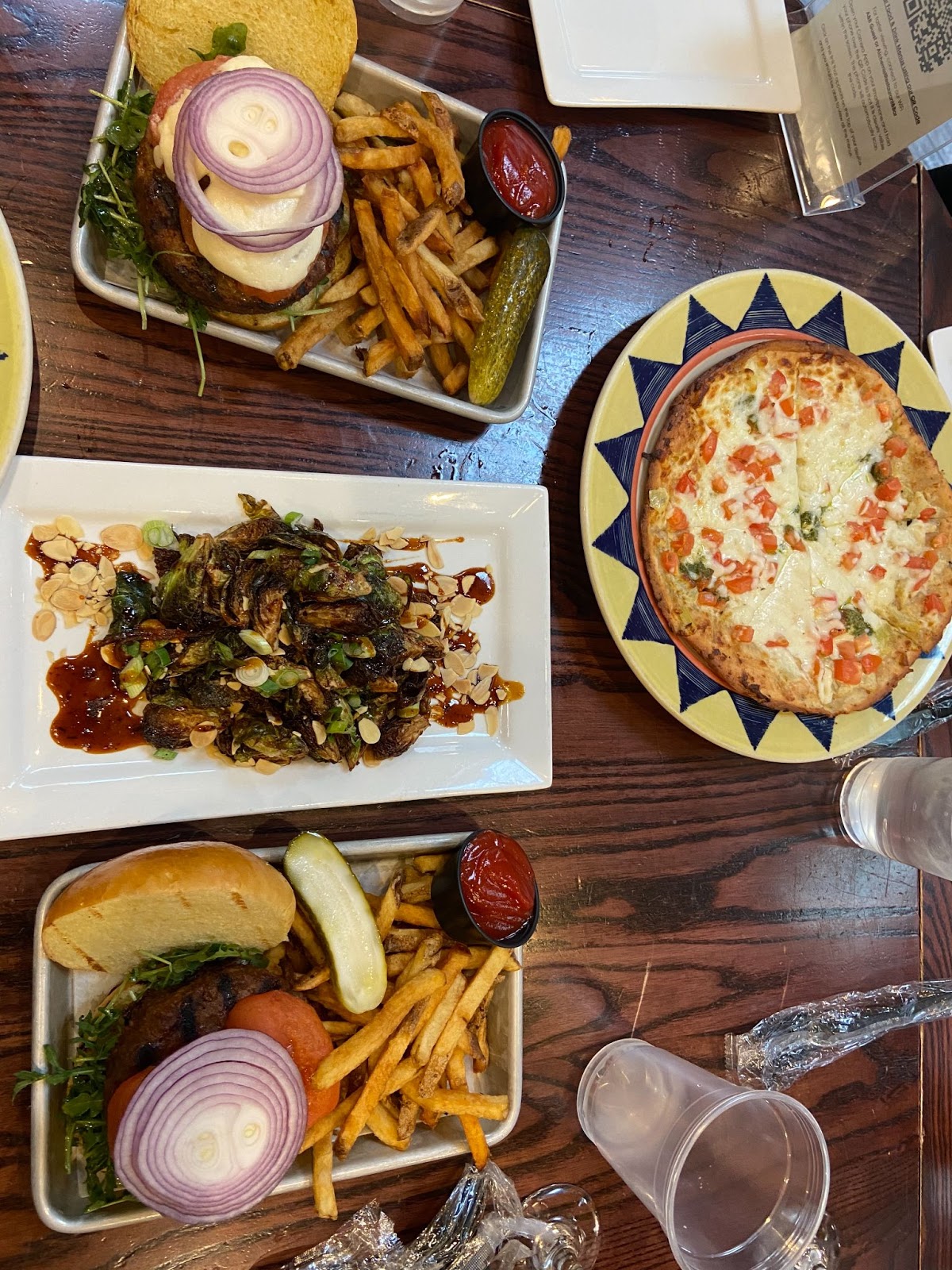
Alchemist and Barrister far exceeded my expectations to say the least. A big contributor to this was an appetizer special they had for the week which was crispy brussels sprouts with almonds and an asian sauce. I went to eat here with some friends and the brussels sprouts were immediately gone, everyone raving about the amazing flavor. If you see this menu item on the weekly specials again, you must go! An absolute 10/10 and I plan to try and make brussels sprouts at home like this! The other appetizer we ordered was the cauliflower crusted pizza which had mozzarella, pesto, and diced tomatoes. I thought this pizza made for the perfect appetizer and the cauliflower crust was a delicious, plant-forward edition. Lastly, I ordered the beyond burger which was probably the best beyond burger I’ve had at a restaurant. They made the burger really thick, which is my personal favorite type of burger, and the brioche bun, red onion, and arugula were all really awesome editions. The french fries on the side were crisp and flavorful and the pickle was beautifully salty and crunchy. I can honestly say I would return to Alchemist and Barrister and would be excited about doing so… especially if they have those brussels sprouts!!
Mistral – Most Interesting-Tasting
Price: $$$
Bang for Your Buck: ★★★
Creativity: ★★★★
Plant Forward: ★★
Taste: ★★★★★
Ease of Access: ★★★★
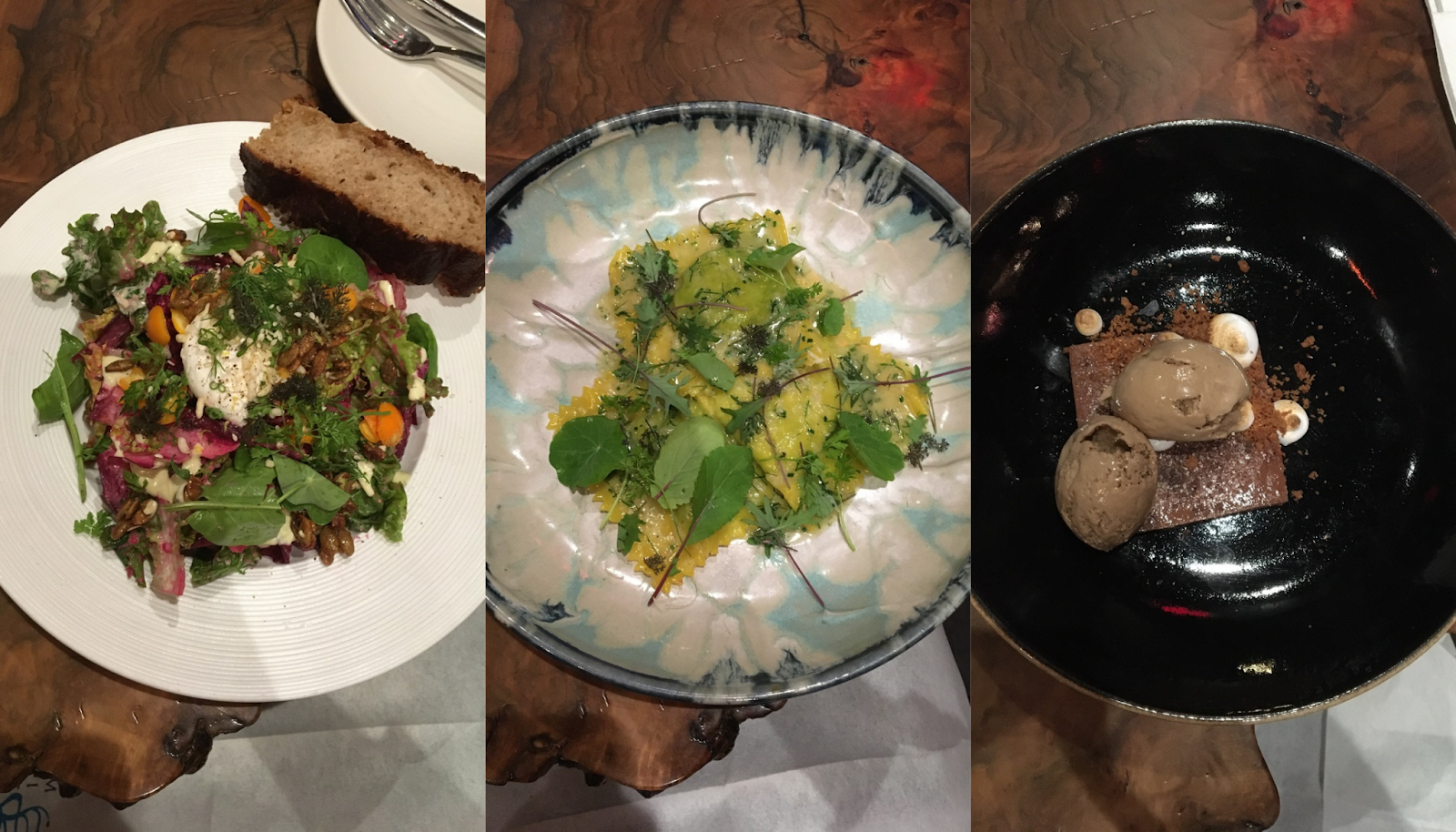
Mistral is a sophisticated restaurant and bar at the end of Witherspoon, right across from Princeton Public Library. While it has a relatively few vegetarian options (and no vegan options), their dishes are all quite tasty. The ambience is rather cozy, and the atmosphere is not too formal, despite being a high-end restaurant. This week I ordered the endive and beet salad, the herb and ricotta ravioli, and the chocolate tart. I was extremely satisfied with all three dishes, but the highlight of the meal was actually the beet salad. The mix of textures and tastes was well-composed and well-executed. Mistral was an overall positive experience, and I am glad to have visited this week.

*** We are not food critics, but food enthusiasts. This is in no way intended to be a formal critique or review of any restaurant in Princeton, merely a way to encourage students to try more plant-based options when dining out.